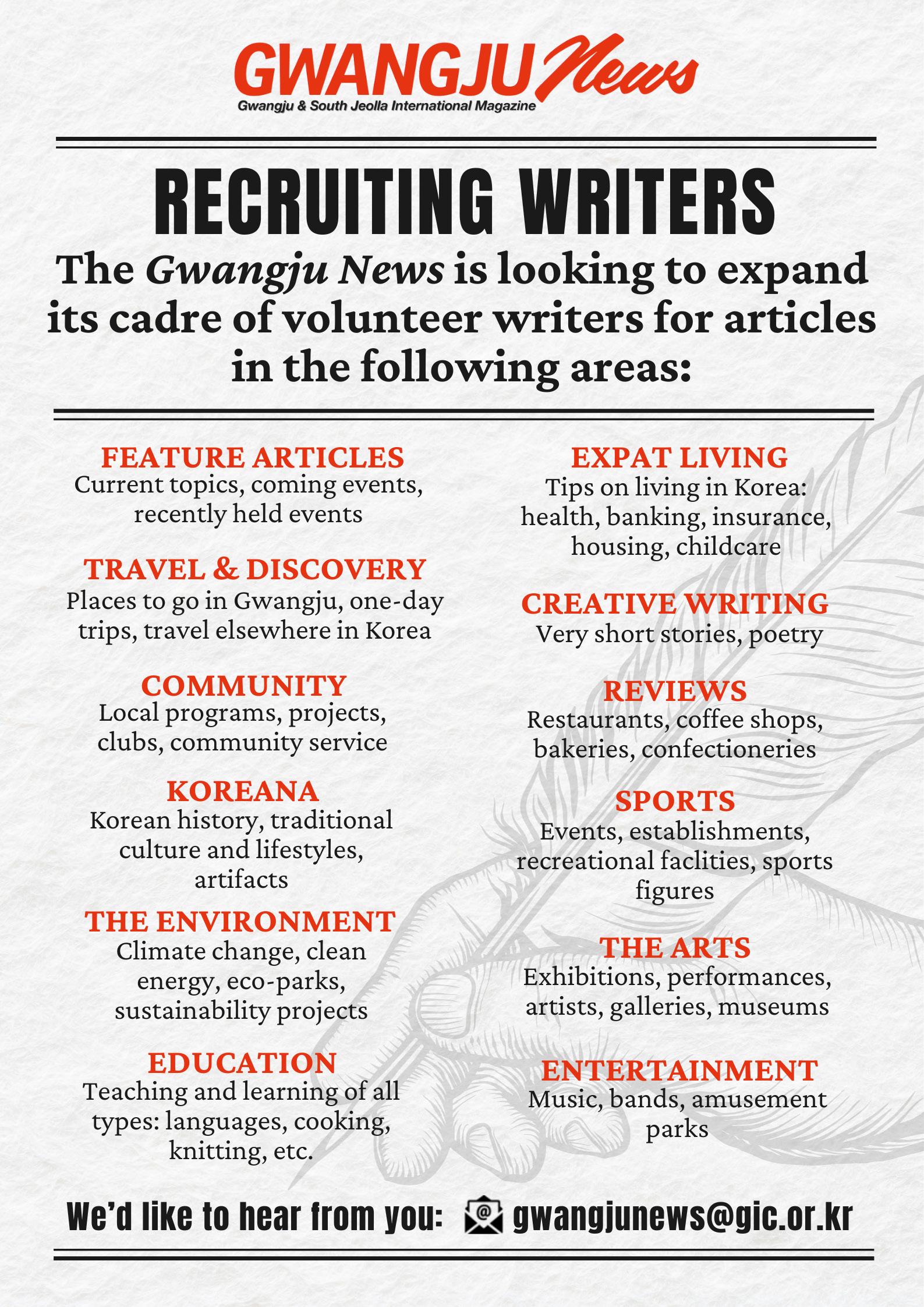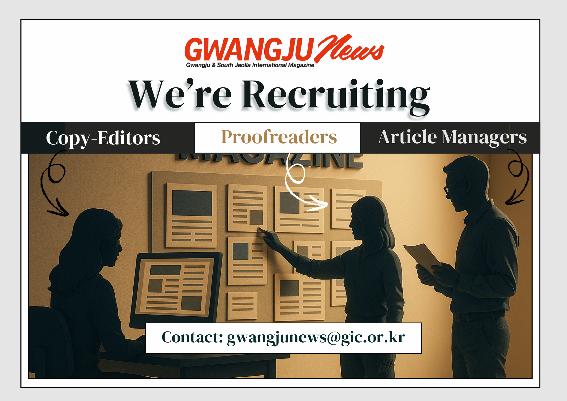Gwangju in Mongolia
People Diplomacy


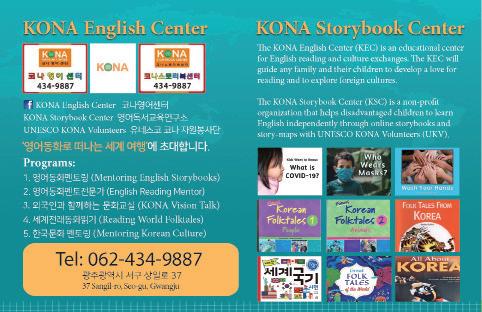
Gwangju & South Jeolla International Magazine




Gwangju & South Jeolla International Magazine

August 2025, Issue 282
Published: August 1, 2025
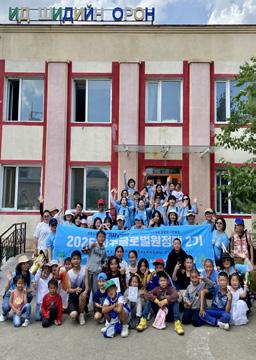
Cover Photo
Magic Land, Mongolia
Photograph courtesy of the Gwangju International Center
Publisher Dr. Shin Gyonggu
Editor-in-Chief Dr. David E. Shaffer
Copy Editing Dr. David E. Shaffer
Layout Editor Johanna Lezada
Online Editor Johanna Lezada
The Gwangju News is the first English monthly magazine for the general public in Korea, first published in 2001. Each monthly issue covers local and regional issues, with a focus on the roles and activities of the international residents and local English-speaking communities.
Copyright ©2025 by the Gwangju International Center. All rights reserved. No part of this publication covered by this copyright may be reproduced in any form or by any means –graphic, electronic, mechanical, photocopying, recording, or otherwise – without the written consent of the publisher.
The Gwangju News is published by the Gwangju International Center: Jungang-ro 196-beon-gil 5 (Geumnam-ro 3-ga), Dong-gu, Gwangju 61475, South Korea
Tel: (+82)-62-226-2733
Fax: (+82)-62-226-2731
Website: www.gwangjunewsgic.com
Email: gwangjunews@gic.or.kr
Registration No. 광주광역시 라. 00145
ISSN 2093-5315
Registration Date: February 22, 2010
For volunteering and article submission inquiries, please contact the editor at gwangjunews@gic.or.kr

We welcome this month and the August issue of the Gwangju News with “heated” applause! Of course, one would expect nothing less than “heated” as the mercury hits 35°C on a daily basis and we doggedly plod through Sambok, the Korean dog days. But no worries; here at the Gwangju News, we take to heart the Korean saying i-yeol, chi-yeol (fight heat with heat). Yes, we have been fired up in working on this August issue from the very first spark!
Our cover feature takes us to the cooler climes of Ulaanbaatar, Mongolia. A group of Gwangju residents made the northwestern trek for people-to-people diplomacy. The delegation discussed climate change and desertification, planted trees, taught taekwondo and K-pop, and much more.
The first of our history and tradition articles pays tribute to Admiral Yi Sunsin and his remarkable naval victory at Uldolmok (Myeongnyang) while vastly outnumbered by a fleet of Japanese warships. August 15 is Gwangbok-jeol – the restoration of light. Our story “Gwangbok-jeol: 80 Years of Liberation” pays tribute to that day and to those who sacrificed to make that liberation possible.
Summer is the time for travel. In our pages, we take you on a trip to a destination were you can beat the heat on icy beaches, visit its cool waterfalls, admire its geysers, and climb into its highlands – Iceland! Nearer home, you can visit the Busan Sea Festival. At Dadaepo Beach, you can enjoy the music and cultural events as well as water sports and wellness sessions. And even closer to home, you are taken on a tour of the Suncheon Bay National Garden, the Suncheon Open Film Set, and the Nagan-eupseong Folk Village.
What’s going on in town? We introduce you to KEET 2025, the Korea Environment and Energy Trade Fair; we tell you all about this year’s UNESCO Youth Camp, which focused on AI; and we let you know about ACE Fair Gwangju 2025, celebrating Asian content and entertainment.
And there’s much more: We bring you a report on K-pop concerts. We tell you who the “Hampyeong Tigers” are. We explain teenytiny nanorobots. We ask “Why study?” Our book review is of Light in August. Our designer vintage shop review is of Rocket Salad. And our column debuting this month is Inside the Gwangju News, featuring one of our writers each issue. Enjoy all this and more!
David E. Shaffer Editor-in-Chief Gwangju News

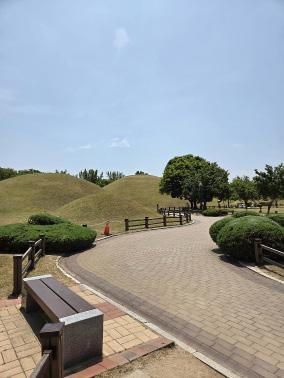
Wanna dive into Korean History? Seoul? Too Modern. Jeonju? Too Joseon. Gyeongju? Now we’re talking. Where you don’t just see the artifacts, you live among them.
The Daereungwon Ancient Tombs are a complex of Silla era tombs located in the heart of Gyeongju, Gyeongsangbuk-do.
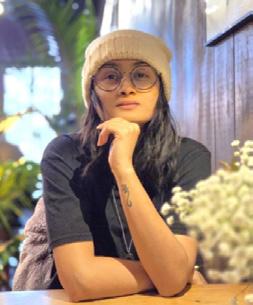
The Photographer
Dhivyaa, an adventurous soul who loves exploring historical gems. This summer, her journey takes you through Gyeongsangbuk-do. Need a guide for your Gwangju-toGyeongju adventure? Don’t miss her upcoming article next month! #TravelWithDV
Inside the Gwangju News: Writer Extraordinaire – Neha Bisht
31 Exhibition: KEET 2025 – Korea Environment & Energy Trade Fair at KDJ
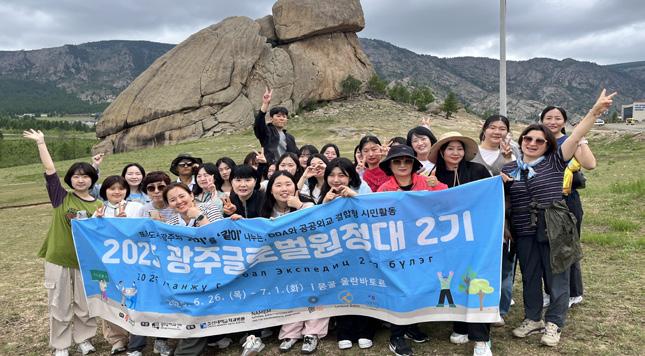

& TECHNOLOGY 34 Nanorobots: Particles for Big Problems
TEACHING & LEARNING
36 Language Teaching: Alphabet Soup – Making Sense of ELT’s Menu of Acronyms and Initialisms
38 Bridging Cultures Through Stories: Ukrainian Student Volunteers in Gwangju
OPINION
39 Study, Graduate, Confused: A Real Portrait of Today’s Academia
CULTURE AND THE ARTS 41 ACE Fair Gwangju 2025: Where Culture Content and Commerce Conjoin
43 Book Review: Light in August
SPORTS & ENTERTAINMENT
45 From CAPTCHA Battles to “Safety Zone” Tears: My 2025 K-Pop Concert Trilogy 47 Area Sports Round-Up 49 “Hampyeong Tigers” Spark Kia’ s Stunning Surge
August Upcoming Events
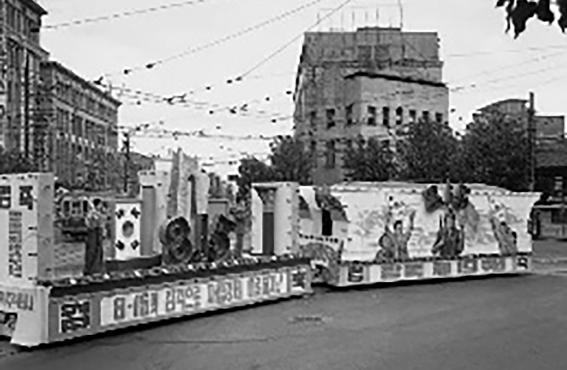
August 15 marks the 80th anniversary of Korea’s liberation from Japanese colonial rule in 1945. This year, the city of Gwangju observes the day with deep reverence, reflecting on its painful past and honoring the hard-won values of freedom and democracy that shape today’s Korea.
In Korean, Liberation Day is known as Gwangbok-jeol. The term gwangbok (광복, 光復) literally means “restoration of light,” signifying the end of 35 years of colonial occupation and a historic turning point in Korea’s journey toward sovereignty. And jeol means “day/ period.” Liberation Day is widely regarded as the symbolic beginning of Korea’s path to becoming an independent and democratic nation. The government of the Republic of Korea was formed on August 15 three years later, in 1948.
Gwangju, in particular, holds a significant place in Korea’s democratic history. Known as the birthplace of the May 18 Democratic Uprising in 1980, the city stands as a powerful symbol of resistance against oppression and the enduring pursuit of human rights. For this reason, Liberation Day in Gwangju carries profound meaning, serving not only as a remembrance of the past but also as a reaffirmation of the city’s commitment to protecting freedom and democracy.
To honor the legacy of Korea’s independence movement, Gwangju residents are visiting
historical sites and memorials dedicated to independence activists. Cultural organizations across the city are hosting exhibitions, lectures, and performances that reinterpret the significance of liberation in a modern context.
One of the highlight events this year is a special concert at the National Asia Culture Center’s Arts Theater on August 14 (Thursday). Co-hosted by the Gwangju City Symphony Orchestra and the Gwangju City Children’s Choir, the performance features patriotic music such as Ah! Korea (A! Daehan-minguk) and commemorates those who sacrificed for the nation’s freedom. The event will also include a ceremony to recognize distinguished independence patriots and contributors to the community.
In addition to local events, major cities across the country – including Seoul, Daejeon, and Daegu – are holding large-scale ceremonies, remembrance events for independence fighters, and citizen-participation cultural programs, emphasizing the continued importance of national pride and historical memory.
The 80th anniversary of Liberation Day is not merely a reflection on the past. It is a moment for all Koreans to come together in unity, reaffirming their shared responsibility to safeguard liberty and democracy while building a brighter future. Gwangju, rooted in its historic legacy, is embracing this milestone as an opportunity to promote community solidarity, cultural pride, and collective vision for the years to come.
“Gwangfrica” Returns: Scroching Heat Disrupts Daily Life, Economy
A sweltering heatwave has once again engulfed Gwangju, prompting the return of the city’s wellknown nickname, “Gwangfrica” – a portmanteau of Gwangju and Africa that humorously describes
the city’s intense summer heat. While the term is often used lightheartedly by locals, this year’s prolonged heat is proving difficult to laugh off, posing real threats to public health and livelihoods.
According to the Korea Meteorological Administration, the heatwave, which began in late June, is expected to continue through August. Daytime temperatures have been hovering around 35°C (95°F), with nighttime tropical conditions offering little relief. As of early July, the heat has already taken a toll on residents. In Gwangju alone, 17 people were treated for heatrelated illnesses as of early July, with an additional 63 cases reported in South Jeolla Province.
The relentless heat is also impacting food prices, especially in the fresh produce market. Leafy vegetables such as lettuce and perilla leaves, which are highly sensitive to high temperatures, have seen a drop in supply and a corresponding price increase. On the other hand, items like peeled garlic and Cheongyang chili peppers, which are currently in their harvest period, are experiencing price declines due to increased availability.
“It’s too hot, and even delivery fees have gone up. ”
The heatwave is hitting small business owners particularly hard. Some local delivery service providers have introduced a “heat surcharge,” which requires restaurant owners to pay extra fees to compensate delivery workers operating in extreme heat. Although demand for food delivery remains steady, the number of in-store customers has declined, and higher delivery fees, combined with food storage challenges, are placing a heavy burden on business owners.
“We can’t stop working just because it’s hot,” one local restaurant owner said. “Even if we can’t
afford the delivery fees, we can’t afford to lose our customers either.” Many small businesses are now facing a combination of reduced foot traffic, higher operating costs, and increased health risks.
The heatwave in Gwangju is not just an inconvenience – it is a complex disaster with cascading effects on public health, agriculture, and small businesses. Abnormally high temperatures are no longer isolated incidents; they have become a recurring summer reality. This calls for comprehensive action, not only from individuals taking care of their own health but also from local governments in building robust heat response systems.
Efforts must focus on protecting vulnerable populations, improving disaster preparedness, and introducing industry-specific support measures. As climate change accelerates, communities like Gwangju are confronting the urgent need to adapt to these increasingly extreme weather conditions, not as temporary anomalies but as the new normal of summer life.
The Kia Tigers have been capturing national attention with what many are calling a miraculous surge in the 2025 KBO League. On July 5, at their home stadium, Gwangju-Kia Champions Field, the Tigers delivered a stunning 13–0 victory over the Lotte Giants, temporarily securing second place in the league standings.
What makes this achievement even more remarkable is the team’s dramatic rise from the bottom of the table. Having started the season in last place, Kia steadily climbed the ranking –9th, 8th, 7th… – eventually reaching the coveted second-place position. It has been a season of unexpected reversals and growing momentum.
However, the following game saw the Tigers fall to Lotte 4–2, dropping them back to fourth place. Despite the setback, the team’s recent performance and fighting spirit have fueled optimism among fans for the remainder of the first half of the season.
The Tigers’ progress is even more impressive given their recent challenges with injuries to key players. In the face of these obstacles, reserve players from the second-tier squad have stepped up, proving their strength and depth. As the season continues, fans are eagerly watching to see how the rest of this unpredictable journey unfolds.
Gwangju has long been known as a “baseball city,” and recent events have only reaffirmed that reputation. Kia’s home games have seen a string of sold-out crowds, and fans have lined up for hours just to purchase team jerseys. This level of enthusiasm goes beyond sport; it reflects a deep sense of local pride and community spirit.
As the Kia Tigers continue their dramatic run, all eyes are on how this remarkable season will end. With unwavering fan support and a team fueled by determination, hopes are high that the Tigers will finish strong and make this a summer to remember for Gwangju.
In Korea, August marks the peak of the summer vacation season. While beaches and water parks remain popular destinations, many Koreans also enjoy distinctly local traditions that differ from those in Western countries.
One of the most iconic summer experiences in Korea involves cooling off in a mountain stream. Families and friends dip their feet into the cold, clear waters; chill watermelon in the stream; and
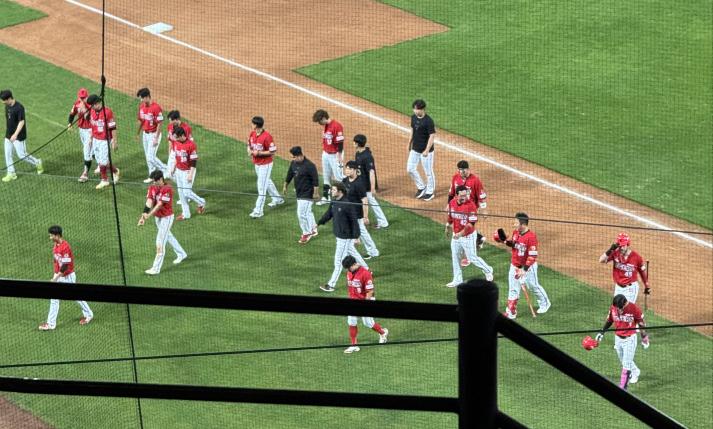
enjoy a hot bowl of baeksuk, a traditional chicken soup simmered with garlic and ginseng. This seemingly contradictory custom of eating hot food on a hot day follows the traditional Korean belief of iyeol, chiyeol (이열치열), meaning “fight heat with heat.” It’s a way to restore energy and promote health during the exhausting summer months.
With around 70 percent of Korea’s land covered by mountains, valleys and streams are easily accessible even from urban areas. This makes them a favored destination for escaping the heat and humidity of Korean summers. The natural shade and cold water provide a refreshing retreat from the city.
Other popular ways to enjoy the summer include spending the day at large water parks, relaxing on the beach during the day, and watching fireworks or exploring night markets in the evening. In recent years, “glamping” – a more luxurious form of camping (glamor + camping) – has become increasingly popular. Many people now spend their summer nights in tent resorts by a forest or the riverside, grilling meat and enjoying the cool night air.
Wonhyo Valley, Mudeung Mountain (Dong-gu, Gwangju)
A beloved summer getaway where visitors can enjoy playing in the water and dining nearby.
Dolmeori Beach, Hampyeong
Just one hour from Gwangju, this beach offers seasonal activities, such as shellfish gathering and mudflat exploration.
Jungheung Gold Spa & Water Park
Located 40 minutes from Gwangju, this destination features both indoor and outdoor water parks, along with resort accommodations – perfect for a relaxing one-night getaway. When it comes to summer foods, Koreans turn to cold and refreshing dishes like naeng-myeon (cold noodles), kong-guksu (soybean cold noodles), and pat-bingsu (shaved ice with sweet red beans and toppings). Seasonal fruits like watermelon, peaches, and Korean melons (cha-moe) are also popular choices for beating the heat.
On July 21, the South Korean government announced a nationwide cash distribution plan aimed at revitalizing domestic consumption. Under the new policy, every South Korean citizen will be eligible to receive up to 250,000 won (approximately US$180) in the form of consumption coupons.
The coupons will be distributed through local governments and issued as local currency, credit/ debit card points, or prepaid cards. The primary goal of the initiative is to stimulate spending during the summer holiday season and boost the domestic economy amid concerns over slowed economic growth and weakened consumer sentiment. The government hopes this move will help curb inflation and restore economic vitality.
While the program is primarily intended for South Korean nationals, certain categories of foreign residents are also eligible to receive
the benefits. These include the following three groups:
• Foreigners listed as part of the same household as a Korean national
• Those enrolled in Korea’s National Health Insurance system (as subscribers or dependents)
• Holders of long-term residence permits, such as F-5 (permanent resident visa), F-6 (spouse of Korean national), and F-2-4 (refugee status)
The distribution will occur in two phases:
Phase 1: All eligible individuals will receive between 50,000 won and 450,000 won, depending on specific criteria.
Phase 2: An additional 100,000 won will be provided to approximately 90% of the population.
Recipients must choose one of the following formats to receive the coupons: credit/debit card points, local gift certificates (jiyeok sarang sangpumgwon, 지역 사랑 상품권), or prepaid cards.
Applications must be submitted between July 21 at 9:00 a.m. and September 12 at 6:00 p.m. Those who miss the deadline will not be eligible to receive the coupons. The coupons must be used by November 30, 2025. Any unused balance after this date will expire and cannot be reclaimed. To check your individual eligibility and benefit amount, you can visit the Gukmin-biseo (국민비서, Korean Government Notification Service) website and request your personal information.
This government measure is expected to offer timely support to households and small businesses, while encouraging spending in local economies across the country.
Compiled by Jung Yeonseo
By Park Yeonju
This summer, from June 26 to July 1, the Gwangju International Center carried out a public diplomacy project in Ulaanbaatar, Mongolia. A group of 28 Gwangju citizens participated in three teams: the Education Team, the Korean Culture Team, and the Onsite Support Team. After about a month of preparation, they embarked on their journey to Mongolia, joined by three Mongolian students residing in Gwangju, as well as a dental team from Chosun University Dental Hospital. The Gwangju Global Expedition began its first program in Cambodia in early 2024 and has now conducted its second round this year. Any Gwangju citizen who wishes to contribute to the value of public diplomacy
is welcome to participate. The program brings together people of all ages – from high school and university students to retirees.
“
Inclusive City Gwangju”
To promote the meaning of “Inclusive City Gwangju” to the world, the 2025 Gwangju Global Expedition is a citizen-led initiative that combines ODA (Official Development Assistance) with public diplomacy. “Public diplomacy” refers to a wide range of diplomatic activities carried out not just by governments but also by ordinary citizens and various civil society organizations. This year’s Gwangju Global Expedition organized a wide range of public diplomacy activities. Each
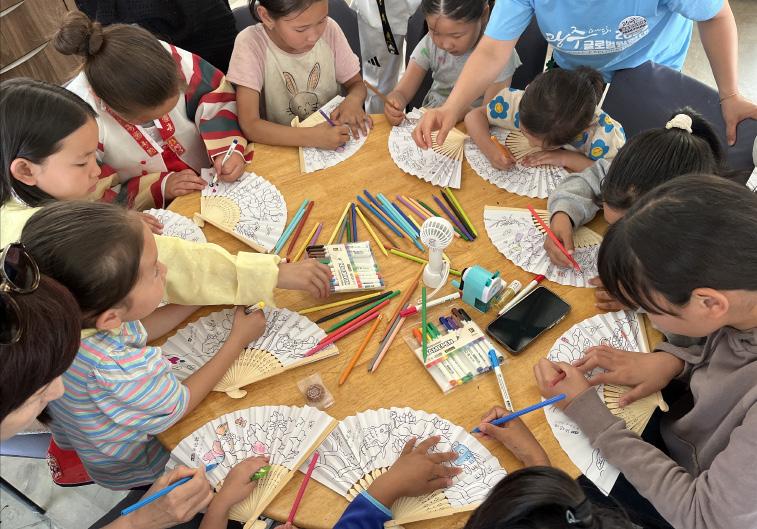
participant contributed by drawing on their academic background and personal experience. Activities included hygiene education, K-pop dance classes, introductions to the city of Gwangju, and caricature drawing. Their efforts extended from self-planned public diplomacy projects to village volunteer work and climate and environmental activities.
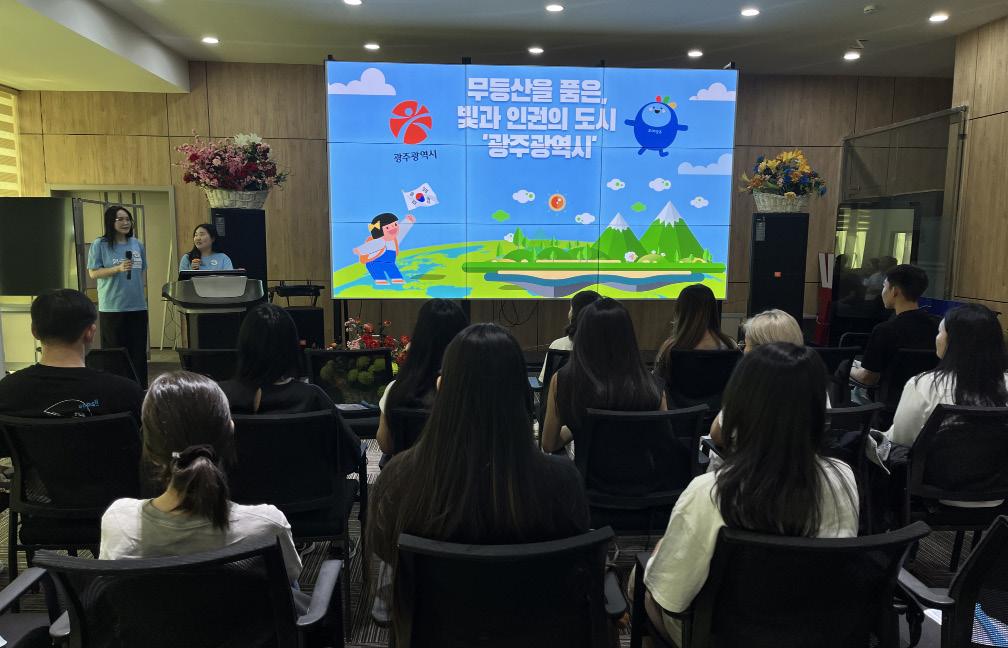
It was a meaningful time not only to share the value of giving with the citizens of Gwangju, but also to reflect on Mongolia’s climate crisis. Before their departure, participants had the opportunity to deepen their understanding of public diplomacy and international development cooperation. They attended a lecture on public diplomacy by a professor from the Department of Political Science and International Relations at Chonnam National University. They also received an ODA lecture from the director of the Gwangju Center for International Development Cooperation. This deeper understanding laid a solid foundation for future public diplomacy efforts.
Ulaanbaatar, the capital of Mongolia, signed a sister-city friendship agreement with Gwangju Metropolitan City in 2016. Marking the tenth anniversary of the agreement this year, the two cities have maintained a close and lasting relationship. With the excitement of carrying out public diplomacy in a city with such strong ties to Gwangju, the Gwangju delegation arrived in Mongolia after a three-hour flight from Korea.
On the first day the team visited NAMEM –Mongolia’s National Agency for Meteorology and Environmental Monitoring. They learned about the country’s climate changes, the climate crisis it faces, and its impact on agriculture. Mongolia, with its vast territory, is experiencing rapid desertification across large areas. To combat this, NAMEM is working to monitor environmental conditions and prevent desertification through tree-planting efforts.
They also mentioned that Korea is the only country that visits regularly for tree-planting volunteer work. This made the Gwangju Global Expedition’s scheduled tree-planting activity even more meaningful during the visit to NAMEM. After learning about the current state of Mongolia’s climate and environment, participants engaged in an open Q&A session. They asked questions ranging from how well the trees are being maintained to how interested Mongolian youth are in the climate crisis. It was a valuable opportunity to gain a deeper understanding of Mongolia’s overall climate and environmental conditions.
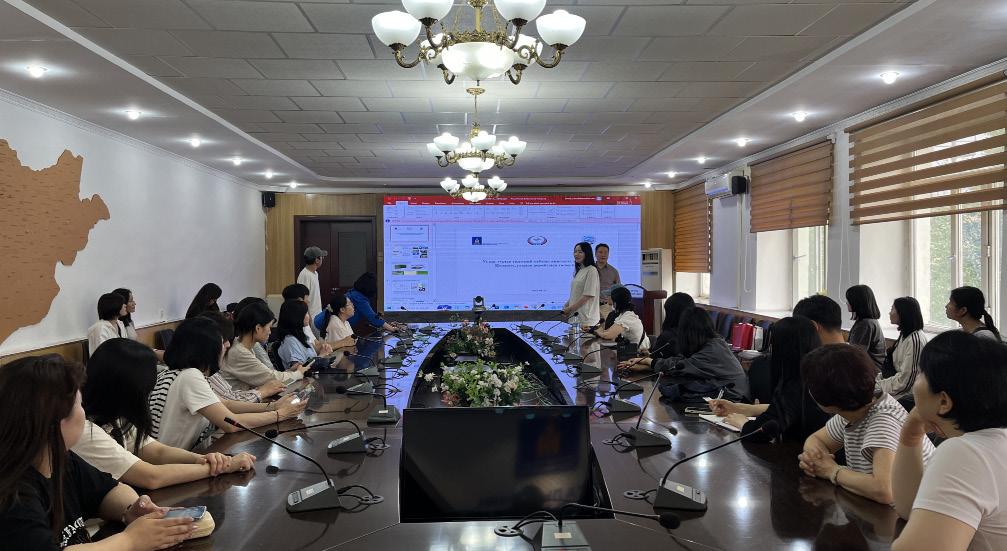
The team also visited the Forecasting Department, where they observed real-time weather changes on screen and took a closer look at how climate data is analyzed. By watching firsthand how weather forecasts are produced in Mongolia, participants gained a deeper understanding of Mongolia’s climate system. Next, the team visited the Supercomputer Room – a facility every national weather agency possesses. They

received an in-depth explanation of how the supercomputer operates 24 hours a day and how the system is managed. Inside the room was the Automated Weather Observation System, installed by Korea. Seeing the logo of the Korea Meteorological Administration and the Korean flag brought a sense of familiarity, and it was a reminder of the strong technological ties between Korea and Mongolia.
At the Ger Innovation Hub, Education Team 1 conducted hygiene education, while the Medical Team provided one-on-one tooth brushing guidance and oral health education. The Korean Culture Team ran a bracelet-making booth, where Mongolian children changed their names into Korean to experience the beauty of the Korean language.
Education Team 2 led activities ranging from traditional fan-making, showcasing Korean aesthetics, to dynamic taekwondo classes held outdoors with the children. The Onsite Support Team collaborated with the Korean Culture Team’s Hanbok-Wearing booth by taking hanbok-themed photographs. They also offered experiences such as hair styling and caricature drawing, providing a variety of fun activities for the children. The children’s faces lit up with bright smiles when they saw the adorable caricatures capturing their unique features.
At first, the children were shy and hesitant, despite their curiosity. However, as they engaged in the activities, they gradually opened up and became more comfortable. By the end, they were fully immersed in the ODA program, enjoying every moment without even noticing the passage of time. In the afternoon, the Korean Culture Team and Onsite Support Team carried out public diplomacy activities centered on Korean Culture at the King Sejong Institute, located at the National University of Mongolia. One participant of the Korean Culture Team gave a presentation introducing Gwangju and shared information about TOPIK, the Korean language proficiency test, deepening students’ understanding of Korean language education.
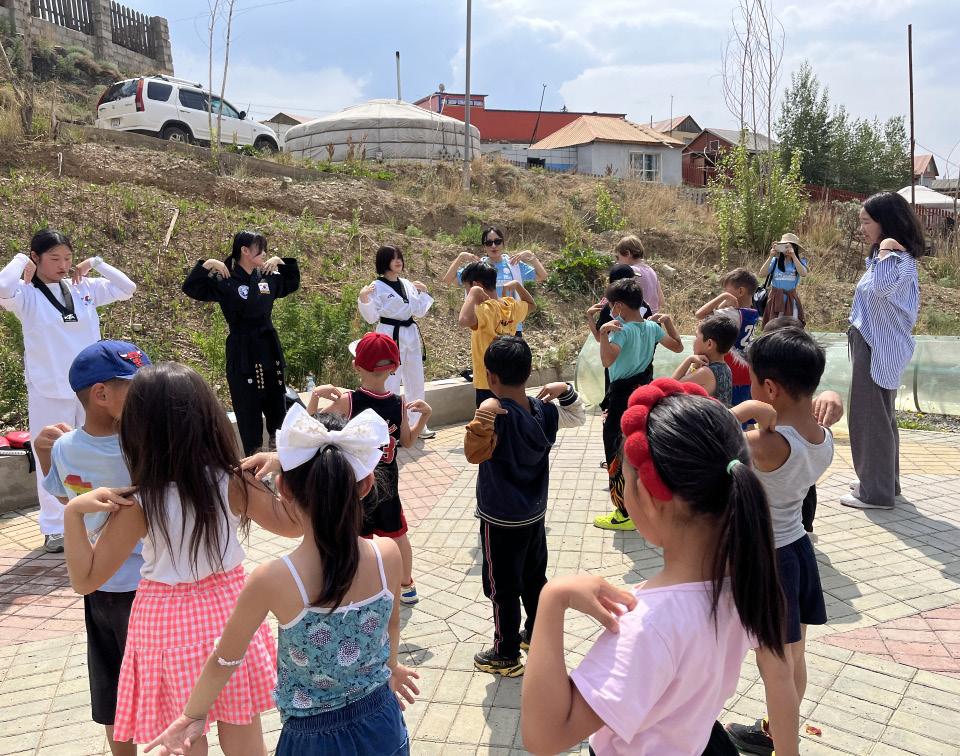
The Korean Culture Team then launched into a variety of cultural experiences, including trying on hanbok attire and Korean-style makeup, as well as Korean calligraphy, taekwondo, and a K-pop dance class. During the K-pop class, students learned the choreography for Jennie’s “Like Jennie,” a hit song that has recently gained popularity both in Korea and abroad. Although many found it difficult at first, as they relaxed, they began to follow the rhythm and fully enjoy the dance. The following day marked the official launch of the ODA activities with a tree-planting initiative. The team visited the desertified area of Moltsukh Els, a dune formation located in the South Gobi region of Mongolia, and also toured the Forest of Coexistence in Bayanhongor.
The Forest of Coexistence is a project jointly promoted by the international environmental organization Green Asia and the Korea Forestry Promotion Institute under the Korea Forest Service. It began in 2022 and aims to prevent desertification through tree planting. The project not only focuses on sustainable forest management but also seeks to empower local communities toward self-reliance. As part of this effort, members of the Gwangju Global Expedition each planted a tree to help sustain Mongolia’s forests. They gave names to their trees and attached message plaques filled with hope, wishing for climate stability not only in Mongolia but around the world.
At the “Magic Land” Mongolian Child Center, further ODA and public diplomacy activities were carried out. One of the highlights was the Korean Traditional Game Festival, where children had the chance to experience traditional Korean games. The festival featured a competition that included games such as ttakji-chigi (slap-match), tuho (arrow throwing), jegi-chagi (Korean hacky sack), gonggi (jacks), archery, and tug-of-war. The children enthusiastically participated in each game, and the atmosphere was filled with cheering and laughter, creating an exciting and joyful experience for all.
Though we spoke different languages, we became one under the shared theme of Korean culture. The curious eyes of the Mongolian children at the beginning and how they gradually grew close to the members of the Global Expedition, eventually walking hand in hand, remain unforgettable moments. It was deeply meaningful to carry out citizen-led public diplomacy in Ulaanbaatar, a sister city of Gwangju. Public diplomacy is something that can be practiced in everyday life, anywhere. The Gwangju International Center continues to develop new public diplomacy initiatives to strengthen exchanges with sister and friendship cities. The 2025 Gwangju 2nd Global Expedition created unforgettable memories of cultural exchange with Ulaanbaatar, Mongolia.

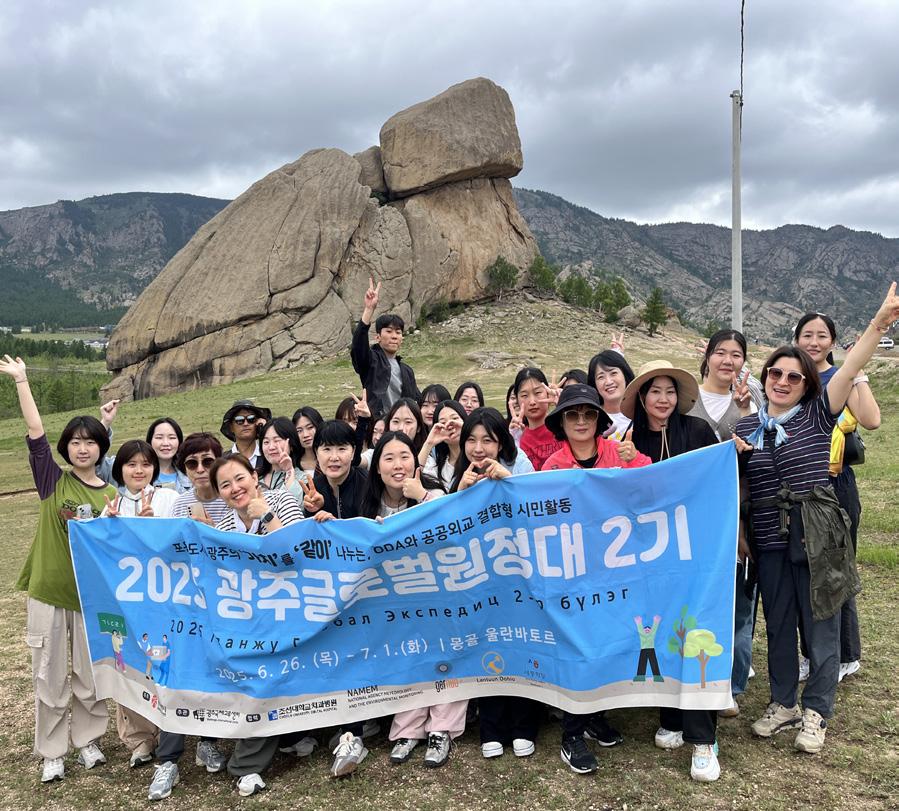

Park Yeonju is an undergraduate at Chonnam National University, majoring in political science and diplomacy as well as Chinese language and literature. Her third major is international development cooperation studies. She was born and raised in Gwangju and wants to promote the colorfulness of the city that she has been a part of for so long.
By Park Yeonju

In 1945, a cheer echoed throughout the land. Korea had finally escaped the sorrow of losing its nationhood and welcomed the complete restoration of independence. Gwangbokjeol, which means “restoration-of-light day” is the national holiday celebrated on August 15, marking the day Korea was liberated from Japanese colonial rule.
But this year is more than just another red-letter day on the calendar. It marks 120 years since the Eulsa Treaty of 1905 with Japan, a painful chapter in our history, as well as the 80th anniversary of Korea’s liberation and the 77th year of the formal establishment of the Republic of Korea. Eighty years ago, we regained our freedom from 36 years of repressive Japanese colonial rule.
Independence has been restored. Yet we know this: Liberation is not complete. The Korean Peninsula remains divided. Unified sovereignty is still unfinished. Reunification, once a national goal, has faded from view. The dream of true independence and a fully restored homeland, as imagined by the Korean Provisional Government (active during the colonial period), has yet to be realized.
Today, the legacy of liberation lives on, not just in monuments or national holidays but in our language, our identity, and our democratic values. The sacrifices of those who fought for freedom laid the foundation for a nation that would rise from the ashes, transform into a democracy, and emerge as a global economic and cultural force. We speak Korean freely (suppressed during colonial rule). We choose our own leaders. We tell our own stories. These are the gifts of Gwangbok – the restoration that previous generations fought for.
“Today, the legacy of liberation lives on … in our language, our identity, and our democratic values.”
To mark the 80th anniversary of Korea’s liberation, the Ministry of Patriots and Veterans Affairs plans to promote a wide range of initiatives under the vision of “80 Years of Liberation: A United Republic of Korea Through Patriotism.” First, the ministry is launching nationwide commemorative programs to honor and carry on the spirit of the independence fighters and to strengthen recognition and support for those who contributed to Korea’s liberation.
Starting with the National Debt Repayment Movement in January, a series of monthly events titled “This Month’s Independence Movement” are being held throughout the year across
the country, delivering a message of national resilience and unity to all regions of Korea. In Gwangju as well, various commemorative events have already been held to honor this historic milestone, engaging youth and local communities in remembering the spirit of independence and patriotism.
To also mark the 80th anniversary of liberation, the Battle of Bongo-dong, where the Korean independence army defeated Japanese forces in 1920, will be reenacted as a water gun festival on August 15 in the Goryeo-in Village in Gwangju’s Gwangsan-gu. This citizen-participatory cultural event honors the victory led by General Hong Beom-do. Participants will join a street parade carrying umbrellas decorated with the taegeuk (yin-yang) symbol and Korean flags. Following an actor portraying General Hong, citizens playing the role of independence fighters will march and, upon encountering actors playing Japanese soldiers, will shout slogans like “Long live Korean independence!” and “Long live Korea!” while squirting water with their water guns.
This reenactment of the Battle of Bongodong is more than just a summer event. Commemorating the 80th anniversary of Korea’s liberation, it serves as a living history lesson that remembers the past and looks toward the future. It offers a unique opportunity for citizens to actively engage with and experience the spirit of the independence movement. Far from being simple playfulness, this festival is a meaningful reenactment that allows today’s citizens to reflect on the significance of liberation. The cries of “Long live Korean independence!” echo not as mere slogans, but as powerful reminders of the noble spirit of those who sacrificed their lives for Korea’s freedom a century ago.
As Korea marks 80 years of liberation, the reenactment of the Battle of Bongo-dong is not only a tribute to the past but also a call to the future – a reminder that the journey toward true independence, unity, and peace is still ongoing. The bravery of those who once fought with rifles

in the mountains now lives on in the hands of children wielding water guns, their voices echoing with the same yearning for freedom and dignity.
“The spirit of Gwangbok – the restoration of light –must now guide us toward a brighter future.”
generations: from those who sacrificed their all for independence to those who now inherit the task of protecting democracy, honoring identity, and striving for peace on the Korean Peninsula.
The spirit of Gwangbok – the restoration of light – must now guide us toward a brighter future: a future where division gives way to unity, where history teaches resilience, and where the Korean people, wherever they may be, stand proud, free, and forward-looking as one.

The Republic of Korea has come a long way –from colonization and war to democracy and global influence. Yet the dream of a fully restored, united homeland remains unfulfilled. In this symbolic year, we are reminded that liberation is not a destination but a continuing mission – one carried forward not only by governments and policies but by the spirit of the people. This year’s commemorations serve as a bridge between

The Author Park Yeonju is an undergraduate at Chonnam National University, majoring in political science and diplomacy as well as Chinese language and literature. Her third major is international development cooperation studies. She was born and raised in Gwangju and wants to promote the colorfulness of the city that she has been a part of for so long.
By Park Nahm-Sheik
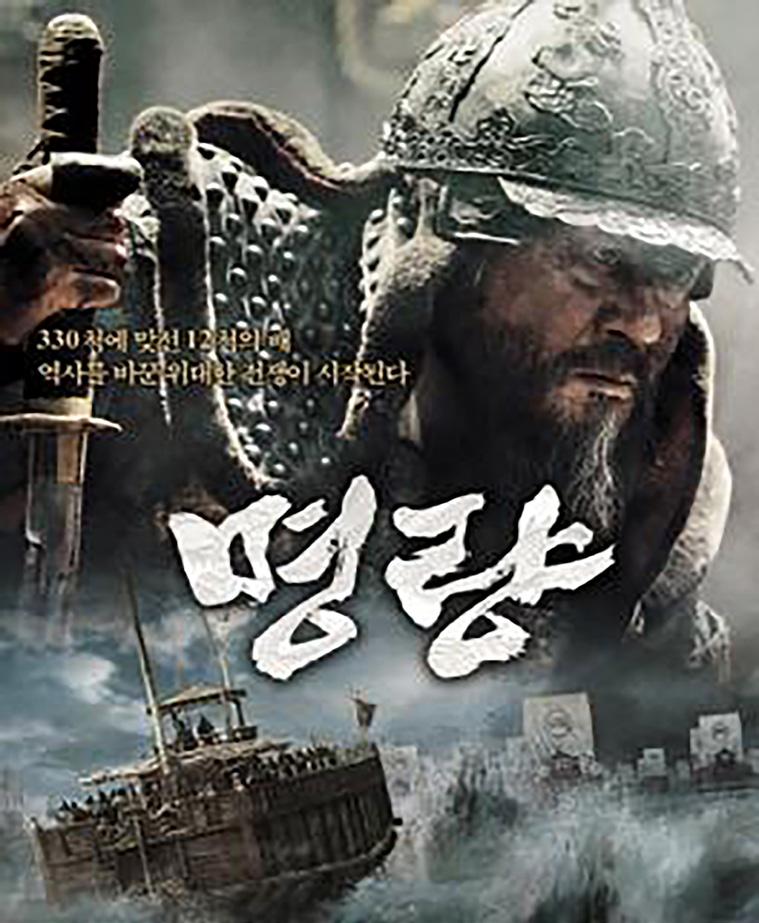
Uldolmok (울돌목) is a wild whirlpool of a strait off the coast of Haenam on the southwestern tip of the Korean Peninsula. To be more precise, it is in the vicinity of Ttangkkeut-maeul (땅끝마을) in the township of Songji. Parenthetically, Ttangkkeut-maeul also goes by the Sino-Korean designation of Tomal (토말), both meaning “land’s end village.” Ul, dol, and mok of “Uldolmok,” respectively mean “crying/wailing,” “swirling/whirling,” and “bottleneck,” which together denote a “challenging passageway.” Uldolmok is often known as Myeongnyang (명량), which happens to be its Sino-Korean rendering. These two words thus are two of a kind, so to speak. I personally prefer “Uldolmok” to “Myeongnyang” for the simple reason that the former is of pure Korean heritage, as opposed to the pedantic Sino-Korean tone of the latter.
Back to our main topic here, Uldolmok is where Admiral Yi Sunsin scored the greatest naval victory of his illustrious career back in 1589 C.E. Quite significantly, Uldolmok happens to rank up there with Trafalgar of the British Isles as one of the most renowned sites of naval warfare in human history. Yi Sunsin’s rout of the Japanese invaders is genuinely on a par with Horatio Nelson’s wiping out of the invading Napoleonic armada. This is why Yi Sunsin is sometimes referred to as “the Horatio Nelson of the Orient.” To be fair, however, it should be the other way around, should it not? For Yi Sunsin’s feat preceded Nelson’s by around two centuries. Their dates speak for themselves: 1545–1598 for Yi Sunsin vs. 1758–1805 for Horatio Nelson.
By the way, it may be suggested here that “Uldolmok” should take the place of “Myeongnyang” in public discourse in this country. The Sino-Korean designation “Myeongnyang” sounds way too groveling or bootlicking toward the cultural legacy of China, doesn’t it? That is, unless you believe that China really is Korea’s big brother. Be that as it may, Uldolmok was the scene of Yi Sunsin’s most memorable triumph. Wave upon wave of battle-hardened Japanese invaders attempted to overpower Korean positions all along the southern coast of the country, including the vicinity of Uldolmok. Yi Sunsin had under his command a mere dozen jerry-built seacraft. Despite a distinct disadvantage in number and size of battleships, he ended up overwhelmingly routing the invading Japanese fleets time and again. How such operations succeeded is simply beyond belief. It is, indeed, utterly beyond description.
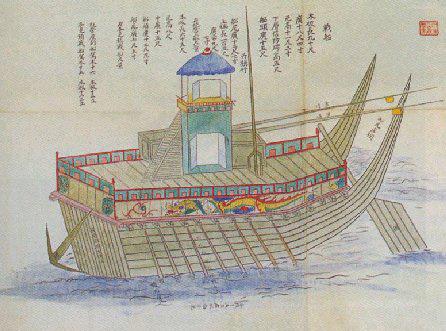

There is also the movie Myeongnyang (English title: The Admiral: Roaring Currents), based on this storied naval engagement at Uldolmok (aka Myeongnyang). On the lips of die-hard movie fans, this has become one of the most talkedabout domestic films of all time. It deserves to be the highest grossing Korean movie of all time that it has eventually ended up being. A genuine blockbuster GOAT movie, as it were. Let’s keep in mind here that Yi Sunsin had under his command a flimsy fleet of a bare dozen vessels pitted against the Japanese juggernaut of 300plus dreadnoughts. Believe it or not, this movie hauled in 127.9 billion Korean won, making it the greatest box-office hit of all time in Korea. Indeed, this does have a lot to say about Yi Sunsin as the most revered hero of the nation.
Despite the dubious seaworthiness of his fleet, however, Yi Sunsin was able to thoroughly outwit and rout the Japanese invaders. He literally handed them a sea burial, which only served them right. Yi Sunsin was able to deploy the wrath of Uldolmok to send the vile foes from Japan on a one-way descent to a permanent resting place on the sea floor. Anyway, the wild currents of the Uldolmok strait did not turn a blind eye to the plight the country was in vis-à-vis the invaders from across the East Sea. Evidently, even Heaven didn’t look the other way when the country was in the direst of straits.
In the face of Uldolmok, the Japanese must have found themselves at their wits’ end. The sheer power of Uldolmok must have sufficed to scare the life out of them. For all their bravado, they must
have been so frightened as to want to turn tail and seek sanctuary somewhere nearby. They must have prayed for an immediate cessation of hostilities.
Of course, “Uldolmok” and “Myeongnyang” refer to one and the same place. And they may often be regarded as two of a kind. As far as I am concerned, however, “Uldolmok” is much nearer and dearer to my heart and soul than is “Myeongnyang.” While we are at it, let’s note that Uldolmok is in the vicinity of Ttangkkeut (or Tomal). Needless to say, I prefer Ttangkkeut” to Tomal” for exactly the same reason that I prefer “Uldolmok” to “Myeongnyang.”


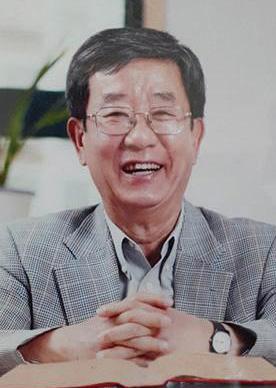
Park Nahm-Sheik is a native of Gwangju. After graduating from Chonnam National University, he went on to receive a master’s degree at the University of Hawaii and a PhD (applied linguistics) at Georgetown University, both in the U.S. Upon completing an illustrious career at Seoul National University, Prof. Park served as president of the International Graduate School of English.
By Michael Attard
The independent country of Iceland lies in the North Atlantic Ocean between the Greenland Sea and the Norwegian Sea. Situated just below the Arctic Circle at 66 degrees north, it stretches at the most 500 km east to west, and 300 km north to south. The total land mass is just over 103,000 square kilometers, and the population of Iceland is only 400,000 people.
“Iceland might just be the escape you're looking for.”
For those of us living in South Korea, Iceland may appear to be an exotic destination too far away to consider as a holiday destination. But what I have come to realize is that Iceland is less than a fourhour flight from many European destinations, and five or six hours from eastern North America. Thus, for some of us who begrudge spending our vacation time just visiting family every year, and not going anywhere else, Iceland might just be the escape you are looking for. And do keep in mind that, while most tourists visit Iceland during the long summer days, the just-as-long winter nights offer fantastic views of the Aurora Borealis, also known as the Northern Lights.
What is there to see and do in Iceland?
Undoubtedly this is a nature destination. On most tours, one is never far from the sea with its black stone beaches. One beach is named Diamond Beach, and aptly so, as smaller icebergs or chunks of ice that wash up onto the shore contrast with the black stones to shimmer just like diamonds. When by the sea, always be on the lookout for rogue waves. These can seem to come
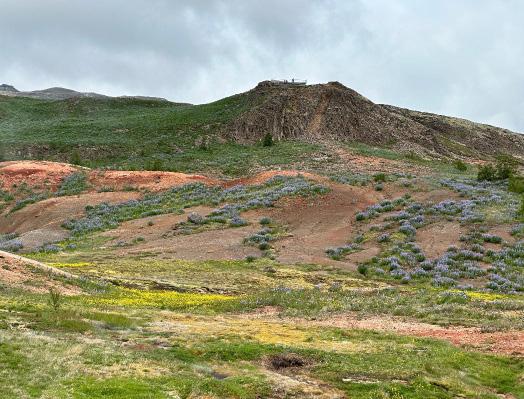
from nowhere, even on a calm sea, and can be deadly.
Iceland is not a very mountainous country, but in the highlands, the landscape is in places quite rugged. In these areas there may be snow at any time of year, as I personally experienced. I traveled in Iceland this past June. I was fortunate enough to see vast areas of the landscape covered in spring flowers. The purple spikes of the lupins were the most common.
Most people know that Iceland is famous for volcanoes. In past geological times and recently as well, there have been some dramatic volcanic explosions. But often, without an explosion, a fissure just opens in the ground, and the lava begins to flow. Every now and then, entire villages need to evacuate. The tour group I was on did visit and climb to the top of what I believe
is an extinct volcano. But more embedded in my memory than the panoramic view from the crater rim is the power of the wind. I don’t know what the wind speed was, but at the top, many people were crawling on their hands and knees, reasonably fearful of being blown away.
Then there are the geysers and waterfalls. Our guide promised us at least one waterfall a day, and he was true to his word. These were all of different widths and heights, but they were all stupendous and loud with the roar of the melting glaciers. One particular waterfall shot off the cliff so powerfully that we were able to walk behind the cascade. Yes, you will get wet.
And I would be amiss not to tell you about what to take to Iceland. Yes, you do need a raincoat – preferably a long raincoat with a good hood. Additionally, rain pants. Even when it is not raining, the blowing wind by the sea or waterfalls will get you wet. Warm clothes are essential. Even


in June, early morning temperatures may be in the single digits. Dress in layers, bring a hat that won’t blow away and gloves that will dry quickly. On your feet, wear proper waterproof hiking boots.
And for the indoors, bring a sleeping mask. During the summer there are 21 hours of sunlight each day. Basically, it never gets dark. The light can mess with your mind. The mask will help to convince your brain that it is time to sleep. Your travel days will be busy; you don’t want to skimp on sleep.
On a final note, Iceland is expensive. I believe that this is because so many goods need to be imported, and there are high taxes, since there are so few people. On the flip side of expensive restaurants, the mutton and cod were the best I’ve ever had.
That then is a quick look at Iceland. In summary, it is a wonderful place to visit, even for just a few days. So if you find yourself in North America or Europe, looking to get off the beaten track, Iceland is a short plane ride away.

The
Author
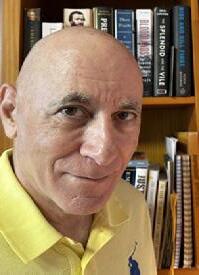
Michael Attard loves adventure travel and has just returned from the land of the midnight sun: Iceland. He says that Iceland is not as wild as Mongolia, but just about. No further travel plans exist just yet, but there are sure to be some soon.
Photographs by Michael Attard.
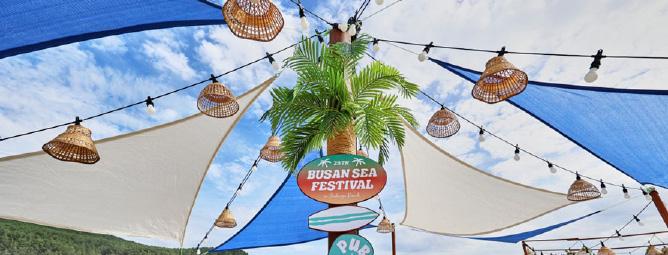
By Neha Bisht
As summer reaches its peak, the city of Busan transforms into a lively coastal celebration with the return of the Busan Sea Festival (부산 바다축제). Held every August, this beloved event blends music, culture, and seaside fun, drawing crowds of locals and travelers for days of vibrant festivities by the sea. In 2025, the festival marks its 29th edition, continuing its legacy as a highlight of Korea’s summer season.
Set against the backdrop of Busan’s stunning beaches – including Haeundae, Gwangalli, Songdo, and Dadaepo – the Busan Sea Festival has long offered a unique blend of music, sports, performance, and tradition. Since its inception in
1996, it has grown into a major cultural attraction, reinforcing Busan’s reputation not only as a seaside destination but also as a dynamic city full of life and creativity.
In previous years, the festival events have been spread across various beaches, each with its own distinct flavor:
• Haeundae Beach has served as the festival’s main stage. As Busan’s most famous stretch of sand, it has hosted open-air concerts, K-pop shows, EDM beach parties, and fireworks displays. Local and international DJs have transformed the beach into a vibrant openair dance floor pulsing with energy late into the night.
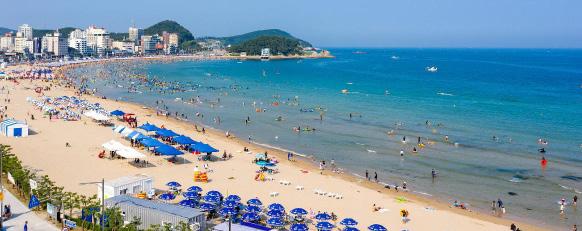
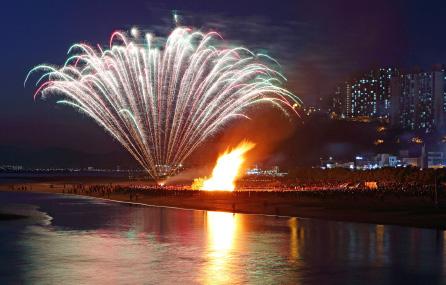
• Gwangalli Beach, set against the glowing backdrop of the Gwangan Bridge, is known for its “Fire and Waves” theme. Visitors have annually flocked to the beach for water and fire shows, yacht parades, busking performances, and interactive light installations, making it a visual and musical delight at sunset.
• Songdo and Dadaepo Beaches have focused more on cultural expression and family-friendly fun. These quieter spots would offer traditional Korean dance, folk music, sand sculpture contests, eco-friendly workshops, and nighttime movie screenings under the stars.
The festival is a paradise for thrill-seekers. Attendees can dive into marine sports such as jet skiing, banana boat rides, kayaking, and parasailing – often at little to no cost. It’s the perfect opportunity to try something new while soaking up the summer vibes.
At the same time, early mornings at the beach offer a different kind of energy. The Beach
Healing and Yoga Sessions include sunrise yoga, meditation, and sound healing concerts, allowing visitors to relax and recharge in harmony with the sea.
Unlike previous editions, the 2025 Busan Sea Festival will be consolidated entirely at Dadaepo Beach. All major programs – from music and cultural events to water sports and wellness sessions – will take place here, creating a unified and immersive festival experience.
Each year, the festival adopts a new theme to welcome visitors. While this year’s theme has yet to be officially announced, it promises the same level of excitement, color, and energy that the Busan Sea Festival is known for.
Day 1 – Aug. 1 (Friday): Opening Splash
• Opening Ceremony – A spectacular beachside kickoff featuring traditional dance,

Nighttime Dance and Light Show. (Visit Busan)
modern performances, and a lively DJ set.
• Sunset Party – Enjoy music and dancing as the sun sets over the ocean.
• Opening Performance – A dazzling mix of music, fire, and theatrical visuals to light up the night.
Day 2 – Aug. 2 (Saturday): Culture & Fun-Packed Beach Life
• Marine Sports – Try kayaking, jet skiing, or banana boat rides.
• Art & Culture Zone – Explore sand sculptures, live art, and street performances.
• Beach Healing – Start your morning with yoga and meditation by the waves.
• Night Beach Festival – DJs, live music, and beachside light displays.
3 – Aug. 3 (Sun): Grand
• Family Zone – Workshops, eco-friendly activities, and performances for all ages.
• Chill & Lounge Areas – Unwind with seaside snacks and parasol-covered lounge spots.
• Closing Ceremony & Fireworks – A spectacular fireworks display to close the festival in style.
The Busan Sea Festival is more than entertainment – it’s a celebration of Busan’s coastal identity,
hospitality, and connection to the sea. The beach promenades are lined with food stalls offering fresh seafood, Korean street food, and cold drinks. Pop-up markets and local art booths showcase the city’s creative side, inviting you to experience Busan’s culture up close.
Whether you want to dance beneath the stars, ride the waves, or simply relax by the sea, the 2025 Busan Sea Festival promises a vibrant and unforgettable summer escape. It’s not just a festival – it’s Busan at its brightest and most joyful.
Admission: Most events are free and open to the public.
Pro Tips: Book accommodations early, stay hydrated, and bring plenty of sunscreen!


A native of India, Neha Bisht is pursuing her PhD research at Chonnam National University’s School of Materials Science and Engineering. She loves to meet new people and make new friends. Neha endeavors to contribute to the wellbeing of society in whatever way she can.
Title photograph courtesy of Busan Metropolitan City.
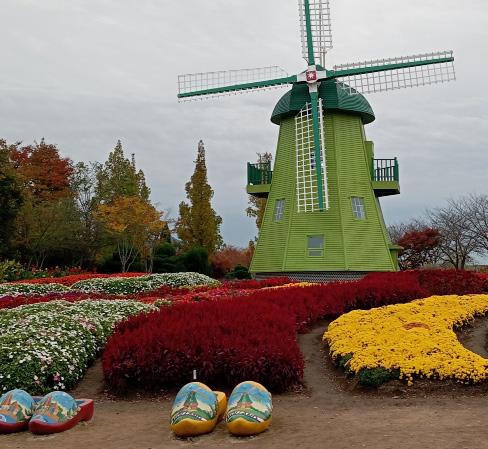
By Julienne Mei Magbanua
f you’re traveling to South Korea and want to go somewhere outside of Seoul, or if you just want to visit a new in-country destination, you can add Suncheon to your travel list! Suncheon is a city located in South Jeolla Province. It is home to tourist attractions that may not be familiar to a lot of foreign tourists but are definitely worth visiting. These include the Nagan-eupseong Folk Village, Suncheon Open Film Set, and Suncheon Bay National Garden.
Nagan-eupseong Folk
It takes about an hour to go from the Suncheon bus terminal to the Nagan-eupseong Folk Village by bus. The way to the walled village requires traveling up a mountain, as it is located at the top. Once you arrive, you will be welcomed by a beautiful view of the mountain range.
The folk village is surrounded by a stone wall and inside are multiple huts. There are figures displayed of people, depicting what life looked like in the early days. (A little disclaimer: Several of these depictions may be disturbing to some.)
There are some activities to try and traditional Korean games in different areas. I visited during Chuseok, so it might be different on a regular day. You don’t have to worry about getting hungry, as there are several food stalls inside as well as souvenir shops. The admission fee for a regular adult is 4,000 won, but fees vary.
If you’re a fan of Korean movies or dramas set in the 1960s to the 1980s, the Suncheon Open Film Set is the place to go. The filming site brought to
life films such as A Werewolf Boy and A Memoir of a Murderer. The place takes you back to the past with its various set designs and props. You can even dress up with their old school uniform rentals to better immerse yourself in the setting and enjoy the old movie theater experience as well. If you’re up for traditional Korean snacks, the film set also has them, and you can witness how they’re made. The entrance fee is 3,000 won for adults, 2,000 for teenagers, and only 1,000 for children.
The Suncheon Bay National Garden is a pride of South Korea. With over a thousand square kilometers in area, the national garden features hundreds of species of flowers and trees, and there are animals as well. The Suncheon Bay National Garden includes several gardens with diverse and unique themes. One of these is the Lake Garden, designed by world-renowned landscape architect Charles Jencks.
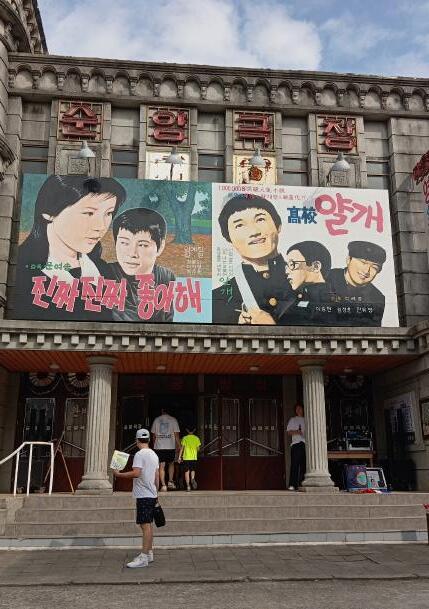
If your feet grow tired of walking, you can grab a coffee at the café or have a meal at the restaurant inside the park. You can also catch live performances by artists or just ride a mini train to take you around. There are other rides that you can try, like the monorail that connects to the wetland park or the boat that travels between the east and west sides of the national garden.
“One of these is the Lake Garden, designed by worldrenowned landscape architect Charles Jencks.”
If you’re planning to go to the Suncheon Bay National Garden, it is recommended to allot at least half a day to fully appreciate its beauty. But if you can only spend a few hours, they offer a discounted rate of 5,000 won if you enter in the evening, which starts at 5 p.m. Regular admission is 10,000 won.
While it may be far from Seoul (around four hours away from where most of the tourists concentrate), Suncheon is certainly worth visiting. From my personal experience, I had a really great time in the city, and it has actually become one of my favorites in the country. Suncheon is an underrated city in South Korea that more people should consider exploring. If I had another opportunity, I would definitely love to go back to Suncheon to visit these sites again, and perhaps check out other tourist spots in the area as well.

The Author
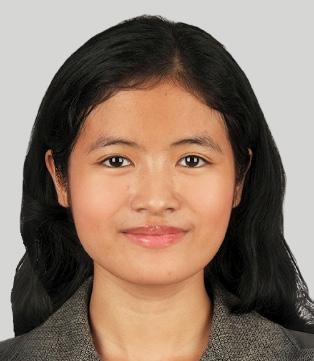
Julienne Mei Magbanua recently graduated with a bachelor of arts degree in political science from the University of the Philippines – Diliman. She spent a semester at Chonnam National University as an exchange student during the fall semester in 2024, where she immersed herself in Korean culture and history. Aside from her interest in politics, Julienne also has a passion for the arts, including music. In everything that she does, she wants to shine the light of Jesus. Instagram @_teresa.music
Photographs by Julienne Mei Magbanua.
By Luis Andrés González
From July 3 to July 8, Gwangju City hosted the 2025 Youth Camp organized by UNESCO (United Nations Educational, Scientific, and Cultural Organization) and APCAD (Asia-Pacific Coalition of Cities Against Discrimination) under the theme “AI for All: Upholding the Value of Inclusion.” The camp brought together 21 young participants from 14 countries to learn, reflect, and co-create a vision for a future with artificial intelligence that leaves no one behind. Designed as a rich and immersive educational and cultural experience, it included expert lectures, workshops, site visits, collaborative projects, shared meals, and more than a few heartfelt laughs.
It’s no coincidence that Gwangju was chosen as the host city. This is not just any place – it is a living archive of Korea’s democratic spirit, globally recognized by UNESCO as a Memory of the World site for the May 18 Uprising. It is also a UNESCO Creative City and a rising hub for AI innovation, backed by local institutions like Chonnam National University and GIST (Gwangju Institute of Science and Technology). Gwangju breathes inclusion, memory, and forward thinking. It is a city where political legacy meets technological ambition, and few places are better suited to imagine a better, smarter, more ethical future.
The camp opened with a powerful lecture by Dr. Gyonggu Shin, Director of the Gwangju International Center, who reminded us that youth-led democracy is not a theory here – it is the city’s lived history. His words grounded the experience with a sense of duty and possibility, reminding us that being young is not a limitation
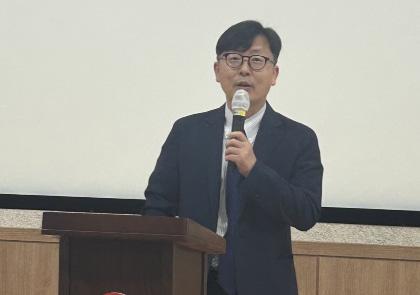
but a superpower. We are not just witnesses of change – we are its drivers.
After visiting Gwangju City Hall, we were officially welcomed by the city’s international ambassador, who emphasized the importance Gwangju places on democracy, inclusion, youth, and its international guests. That same day, Linda Tinio-Le Douarin from UNESCO Paris delivered a compelling lecture titled “Building Capacities of Youth to Become Anti-Racism and AntiDiscrimination Champions.” Her message made it clear that inclusion and scientific progress are not parallel paths – they must intersect. Her presence also reinforced that this camp was not an isolated initiative but part of a broader global movement supported by UNESCO’s vision for ethical, inclusive development.
From vision to action, the baton passed to Agung Zulhatta from UCLG-ASPAC, who invited us to embrace our own political power – not just as activists but as future policymakers and urban designers. His session pushed us to identify
real social challenges in our communities and sparked the first brainstormings that would later shape our group projects. We weren’t there to simulate solutions – we were there to plant the seeds of transformation.
The philosophical side of AI soon entered the picture. Prof. Kang Hyun Jeong, from the Department of Philosophy at Chonnam National University, led a session titled “The Future of the Humanities: Coexisting with AI.” This was a turning point. Technology met ethics, and we were asked to rethink AI not only as a tool but as a mirror of our intentions and values. The question wasn’t just “how” or “for what” should AI be used – but also “why” and “for whom.”
This shift opened the door to deeper concerns: Can AI exacerbate inequality? Will its benefits be distributed fairly? Could it replace the human touch in education or care? These were not far-off speculations; they were urgent questions. Meyda Nento from UNESCO Jakarta, brought these issues to the regional policy level by introducing UNESCO’s Recommendation on the Ethics of AI. She encouraged us to think critically about AI’s implementation across Asia-Pacific cities and to always ask: Who is included – and who is left behind?
With these reflections in mind, we dove into the current realities and future trajectories of AI. Prof. Kim Joonha from GIST presented realworld applications and ongoing research in AI. His session reminded us that Gwangju is not just speaking about AI; it is actively building its future. As a city aiming to become a hub for AI companies and innovation, the responsibility of embedding ethics, inclusion, and sustainability lies at the very core of its vision. For this reason, our generation must be the one to lead – not just adapt.
All these exchanges culminated in team projects where participants developed AI-based proposals to address real social issues. From anti-scam training for the elderly to inclusive public transportation, support systems for deaf and hard-of-hearing communities, and access
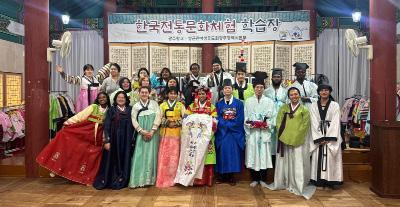
to education for marginalized regions, each project reflected deep creativity and a shared ethical commitment. My own team – formed by peers from Bangladesh, Indonesia, and Korea – proposed a tripartite educational model that integrates AI literacy, emotional well-being, and human reconnection. It was a synthesis of all we had explored: Inclusion is not a checkbox; it’s a philosophy of care.
Throughout the week, it became clear that this camp was more than an event – it was a microcosm of what international cooperation for youth can be. Backed by UNESCO, APCAD, and local academic institutions, it offered not only knowledge but community. Through shared meals, games, and late-night conversations, we discovered that connection doesn’t require sameness – just shared purpose.
In a world obsessed with smartness, we were reminded that no future is truly intelligent if it forgets to be human. The golden rule we took home? AI should never aim to replace us. It should support us all, and reflect our best values. And that begins with us.

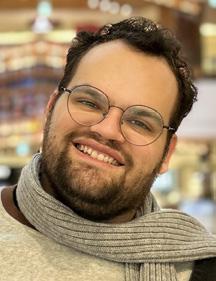
Luis Andrés González is a Mexican Global Korea Scholarship scholar and master’s degree student in cultural anthropology at Chonnam National University. He advocates for LGBTQ+ rights and gender equality, and explores global affairs through pop culture. He is the founder of Erreizando, a digital magazine. Instagram: @luisin97 / @erreizando
Photographs by Luis Andrés González.
By Maryam Ali
Rocket Salad is located near Fashion Street on Chungjang-ro. It’s pleasing to see the growing trend of vintage designers expanding to Gwangju with this store. It’s a modern take on vintage. You can find vintage designers at affordable prices. I first noticed it this spring. The closest bus stop to the store is Chungjang Community Security Center; the bus lines 59, 45, 7, 6, 12, 55, and 74 run there. Additionally, the closest subway station is Geumnam-ro 4-ga.
The store has three floors, each with a retro feel. You can find legitimate designers that are in relatively good condition. In the store, I’ve seen brands like Burberry, Ralph Lauren, Tommy Hilfiger, Levi’s, and many more. On the first floor you can find the seasonal picks. The tills to pay for the items are located at the end of the room on the first floor. The sales personnel are often there ironing and steaming the clothes to maintain the condition of the clothes. In the winter, seasonal sweaters and themed T-shirts are on display. As it is currently summer, a wider variation of summer clothes like T-shirts, basketball jerseys, and summer shirts are on offer.
Moreover, on the second floor you can find an American-themed display. On one side of the room, there is an assortment of formal shirts, and on the other side you can find green armythemed clothes. Lastly, the third floor has a great selection of jackets on offer. My friend bought herself a vintage Burberry coat for 160,000 won that was high quality and had a classic style. In the summer, the third floor has the winter sweaters/ jumpers. (As I’m British, I call sweaters “jumpers.”) I’m a huge fan of jumpers, collecting many different colored jumpers for my collection.

For example, I found a Ralph Lauren sweater for 35,000 won and a Tommy Hilfiger sweater for 42,000 won. I think these are great prices for classic designers that would cost more than 400,000 won at market price. A 10-percent price difference.
To conclude, the store has an online section, although I haven’t personally ordered from the website. I’ve seen the staff take images for the website and can see their dedication in sharing their products. I’ve found that the physical store has more products on offer than the website. But the website has a clearer rating of the condition of the clothes. I recommend visiting the shop to see what they have on offer, since there is more of a selection there.

Open: Monday through Sunday, 1:00 to 9:30 p.m.
Address: 2 Hwanggeum-dong, Dong-gu, Gwangju
Website: https://www.rocketsalad.co.kr/m/index. html
Instagram: https://www.instagram.com/vintage_ rocket?igsh=N2VmeW93MXVncHdn Phone: 0507-1448-0045
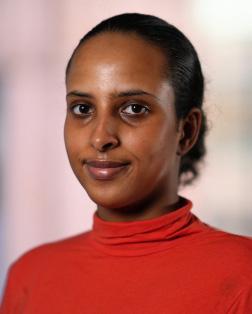
The Author Maryam Ali is currently based in Gwangju. Originally from London, she took the plunge to live abroad and share her experiences in a blog. As a budding journalist, she expresses her fascination with culture, aspiring to understand the world around her. Website: https://sites.google.com/view/maryamaliportfolio/homepage
Photograph by Maryam Ali.
This column features each month one of our regular writers for the Gwangju News for our readers to get to know them better. These windows on the writers follow an interview format. — Editor
Gwangju News (GN): Hello, Neha. To start things off, tell us a little about yourself before coming to Korea.
Neha: Hello! Thank you so much for this opportunity. I’m Neha Bisht, originally from Uttarakhand, India. My family lives in the beautiful hill town of Nainital. I completed my bachelor’s degree in chemical engineering in Uttarakhand, and then moved to Pune, Maharashtra, to pursue a master’s in materials science and engineering. After finishing my master’s, I immediately started working in a research position. Alongside my job, I was actively applying for PhD programs abroad. Before coming to Korea, I had spent nearly three years in research.
GN: What was it that brought you to Korea? Why Korea instead of some other country?
Neha: To be honest, my first preference was not South Korea. I wanted to pursue a PhD in Europe. I was actively applying to top-ranked universities and even received an admission offer from Kiel University in Germany in August 2021. Unfortunately, due to the COVID-19 pandemic, the scholarship I had been awarded was cancelled. I had waited for almost a year for that opportunity, and losing it was very disappointing. Since European PhD admissions usually follow a one-year cycle, I didn’t want to spend another year just waiting. That’s when I started considering South Korea as an option. My master’s advisor, who had studied in Korea himself, recommended several Korean universities. He spoke highly of the research environment, facilities, and the international reputation of Korean institutions. Motivated by his guidance, I began searching for PhD
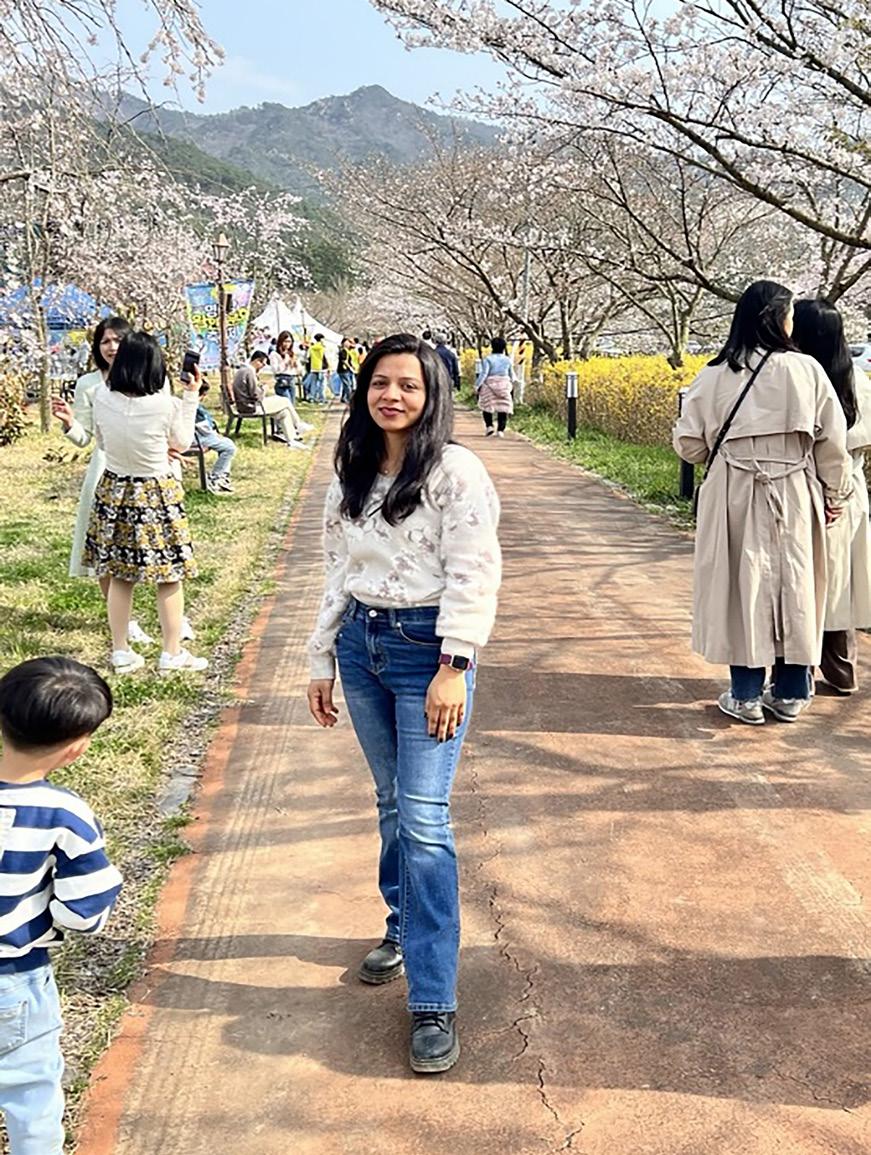
opportunities in Korea around September. I came across open positions at both KRICT in Daejeon and CNU in Gwangju. I applied to both, and fortunately, I received an offer from my current professor at CNU. Although I was also accepted at KRICT, their application deadline was very tight, and I couldn’t complete the document submission in time. So, I decided to proceed with CNU and quickly submitted all the required paperwork. In February 2022, I flew to Seoul and then traveled to Gwangju. Even at that time, COVID-19 precautions were still in place, so I had to undergo a seven-day home quarantine. Once I tested negative, I officially began my PhD journey and started my coursework at the university.
GN: How, and why, did you get involved in writing for the Gwangju News?
Neha: As a researcher, I was already involved in scientific journal writing, but I wanted to try something new, something more creative and community-oriented. I’ve always been interested in volunteering, so when I found out about a Gwangju News volunteer writers’ meeting through social media in April 2023, I signed up right away and took a bus to attend. By the time I arrived, the meeting had already started. A presentation was underway, and many people were gathered, including the editors and other team members. They explained how the Gwangju News operates and how they welcome new volunteers each year to form the writing team. After the presentation, we had some snacks and a chance to mingle. That’s when I met the managing editor at the time. While chatting, I mentioned my passion for photography, and he kindly introduced me to the magazine’s photographer, who handles the Photo of the Month page and feature photography. I asked if I could also submit photos for Photo of the Month and he encouraged me to do so. That’s how my journey with the Gwangju News began.
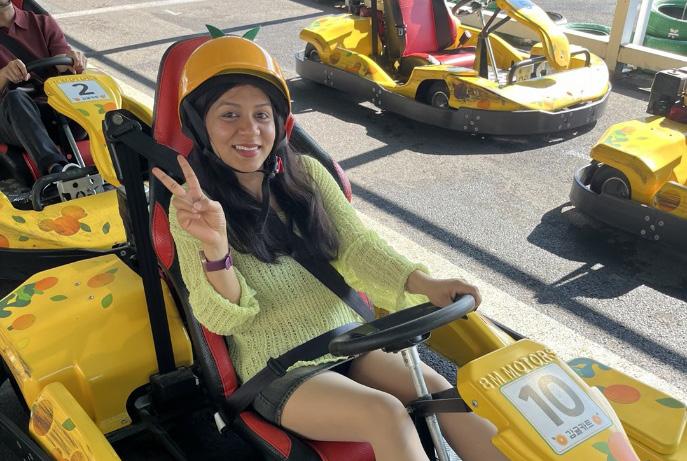
GN: With your doctorate program studies and lab research, how do you find time to visit the spots and the festivals that you write about in your Gwangju News column, Exploring Korea?
Neha: The first couple of years of my PhD were busy with coursework and adjusting to a new research topic, but I still managed to explore places on weekends. In fact, I did most of my traveling and exploring during those early years. Now, as my research has become more intensive,
it’s harder to find time. But whenever I feel overwhelmed by lab work and need a break, I plan short trips with friends to recharge. I also started exploring Korea early on because I believe it’s essential to understand the culture and people of the country you’re living in. It helps make life easier and more meaningful. So, I usually push myself to work hard during weekdays, so I can keep my weekends and public holidays free for travel and discovery.
GN: What are your plans for after you can put “Dr.” in front of your name?
Neha: At this point, it’s hard to say for sure, but my top priority is to secure a postdoctoral position in an English-speaking country. I’d love to continue my research journey in a globally collaborative environment.
GN: Now, for a few rapid-fire, short-answer questions: What is your favorite Englishlanguage book?
Neha: The Alchemist by Paulo Coelho, and Steve Jobs by Walter Isaacson.
GN: Your favorite movie?
Neha: I don’t have a single favorite, but I really enjoy science fiction movies.
GN: Your favorite music genre? Or singer or group?
Neha: I love Bollywood music, and my favorite singer is Arijit Singh. In Western music, I enjoy listening to Maroon 5 and Selena Gomez.
GN: Your favorite place in Korea?
Neha: Hwacheon-gun – it’s surrounded by mountains, rivers, and beautiful natural scenery.
GN: Your favorite Korean food?
Neha: That’s a tough one! As a vegetarian, I have limited options, but I really enjoy sundubujjigae.
GN: Tasty choices, all of them. Thank you, Neha, for allowing us to get to know you better!
Neha: Thank you and the Gwangju News for giving me this opportunity. I hope to continue contributing and sharing more stories in the future!

Interviewed by David Shaffer. Photographs courtesy of Neha Bisht.
By Chung Hyunhwa
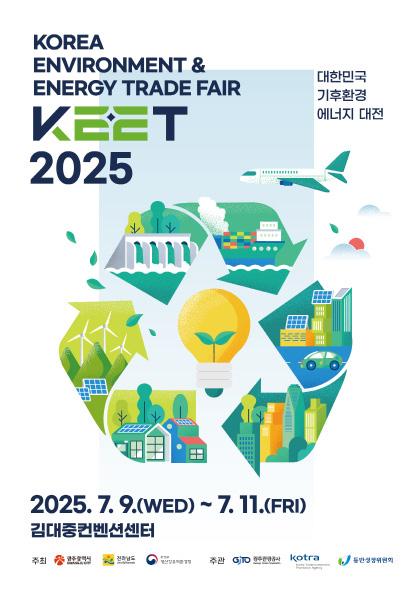
KEET 2025, the Korea Environment and Energy Trade Fair hosted by Gwangju Metropolitan City, Jeonnam Province, and the Yeongsan River Basin Environmental Office, was held for three days from July 9 at the KDJ Convention Center. The major categories of the exhibition were renewable energy, energy storage systems (ESS), smart grids, and various environmental technologies, including pollution control, waste management, recycling, and ESG (environmental, social, and governance) solutions.
I preregistered and got my name tag at the venue on arrival. I was glad to see that the name tags did not come in the usual transparent plastic holders, and also disposable cups were not allowed in an effort to promote a zero-waste mindset. I completed a survey at the entrance and earned a coffee coupon that I used later in the day to get my
drink served in a reusable cup at the café inside. I know the city is running a reusable cup rental service for event holders on request to make it easier to go zero-waste.


When I entered, the first booth was that of a company called Kalsun, based in Naju Innovation City, which manufactures BIPV (buildingintegrated photovoltaics). I had read about BIPV before, but this was the first time I saw real BIPV products. The sample displayed was a clear glass wall tile that had a photovoltaic module inside. The tiles come in different colors and patterns to meet various aesthetic needs. The power generation efficiency is of course highest when they are transparent, but it is good to have such options. To promote BIPV systems, a weighting factor six times higher than that of conventional photovoltaic installations is granted for now, according to the staffer at the booth.

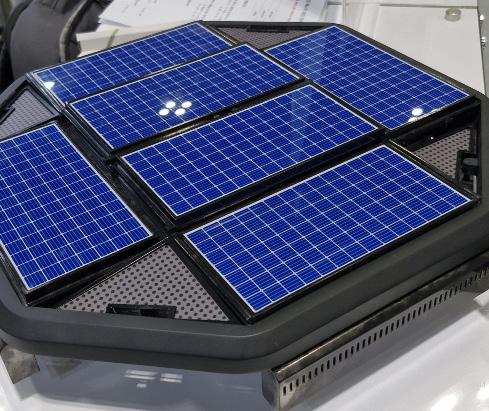
As for the photovoltaic category, another factory that attracted a lot of attention was a company named UEnergy, based in Naju and Suncheon, that displayed a foldable agricultural PV system. I had seen the folding PVs before and wondered why the panels faced in opposite directions, unlike conventional south-facing panels. I got the answer there: Agrivoltaic systems with adjustable solar panels are installed in an east–
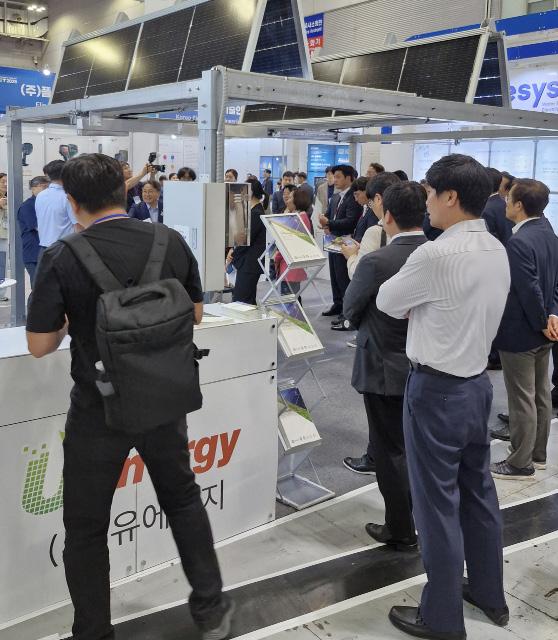
west orientation to avoid energy concentration during midday peak hours and instead distribute electricity generation more evenly across the morning and evening. This can be one solution for the grid saturation in the south. Also, the adjustable design allows the control of sunlight just enough for growing crops, while also functioning as a shade screen to prevent burn damage on the plants during the summer.
Next, I saw a very attractive-looking booth: EcoPeace, a Gwangju-based company. It manufactures solar-powered leisure boats and water purification robots, which are already in operation in rivers and reservoirs. This is a great solution to remove harmful algal bloom and preserve water quality. The solar boat did not have so much of a purifying function because it focuses more on carrying people. I thought they were cool.
Another company based in Gwangju, Hogreen Air, was quite interesting as well. It started as an electronic drone company, but realizing electronic ones can be airborne for only a fairly short period of only 20–30 minutes, it pursued the adoption of hydrogen power for their drones. At the moment, it is focusing on manufacturing drones that can use hydrogen and collaborating with other companies for the hydrogen tanks or fuel cells. Hydrogen leaves only water during combustion, so if hydrogen is produced using
renewable energy and can ensure safety, it will be used more widely due to its high energy density.
KERI’s (Korea Electrotechnology Research Institutes) Smartgrid headquarters in Gwangju was displaying its research projects, and one caught my eye. It was titled “Wireless Energy Transfer System for Lunar Exploration Rover.” Wireless energy transfer, especially in space, is one very important technology because if it becomes feasible, we may be able to bring in solar energy or any other energy generated from space to earth. We would have a very stable energy source 24 hours all year round. I was glad to see such research going on in Gwangju, too.

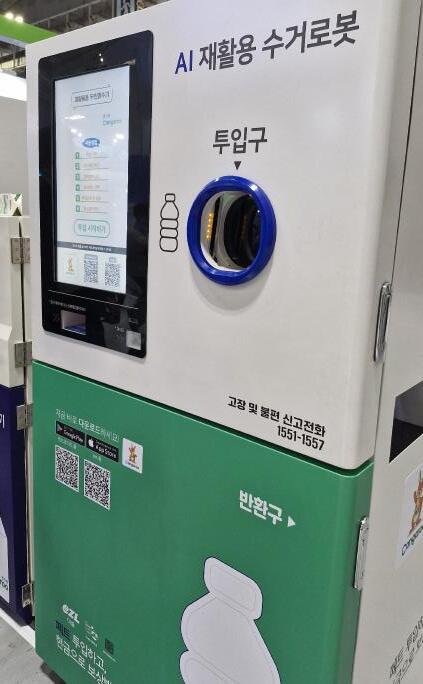
There were so many other intriguing technologies, such as super-alkaline water to replace industrial oil by Hightec, a plasma odor removing device by Samdo Environment, AI recycling collector machines and trash bag collecting devices by KIEcosystem, a multisource inverter by ENPlus, a solar coal maker by YeHan to convert organic matter into coals using only sunlight, industrial odor control solutions by Ecofranc, cooling fog devices by Angaepin coolfog, and all-solid batteries by Dumu. Some were still in the middle of R&D, but nothing is achieved without beginning.
In addition to the exhibition, there was a separate space for trade meetings with the buyers from different countries. The scale of KEET was limited because most of the participating exhibitors were from Gwangju and Jeonnam, but it was a nice opportunity for the locally based companies associated with the above categories. Moreover, I was pleasantly surprised to learn that there were so many companies that envisioned the opportunities in the net-zero goal.
The exhibition also aligns with Gwangju’s industrial focuses on AI, environmental cars for the future, and smart energy. I am glad that these companies espouse the demands of the threatening-climate era and attempt to deal with those demands by using their own creative ideas. I hope for continued active support by the Gwangju city government.

The Author

Chung Hyunhwa, a native of Gwangju, recently worked for a horticultural company. She led the international ecohike group Gwangju Hikers at the GIC in 2020 and 2021. Previously, she taught English at Yantai American School and Yantai Korean School in China and worked in school administration at Branksome Hall Asia in Jeju. She holds a master’s degree in TESOL from TCNJ in the U.S. and a license to teach Korean. She loves plants, birds, and repurposing items creatively.
Photographs by Chung Hyunhwa.
By Saqib Sharif
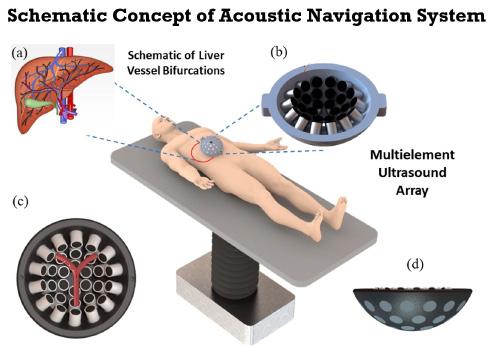
Imagine a tiny robot so small that millions of them could fit on the tip of a pencil. Now imagine these robots swimming through your bloodstream, guided like GPS-controlled submarines, carrying medicine directly to where it’s needed most – like a tumor or an infection. This is not science fiction. It’s the exciting world of micro- and nanorobots for drug delivery, a cutting-edge innovation in modern medicine.
If you do a Google search for nanorobot images, you will see lots of AI-generated and exaggerated images of robots with arms, legs, propellers, GPS, batteries, wings, cameras, lights, lasers, etc. In reality, a nanorobot is just a particle without a battery or microchip controller. In fact, it’s wirelessly powered and controlled from outside using external magnetic fields, acoustics fields, and IR light.
These are microscopic machines – some thousands of times smaller than a grain of sand – designed to move through the human body.
They can travel through blood vessels and even navigate tight spaces like the brain or urinary tract. Think of them as tiny couriers that can bring medication right to the problem spot, minimizing harm to healthy parts of the body.
Microrobots move using external controls such as magnets or sound waves. For example:
• Magnetic fields can pull or push tiny magnetic robots, steering them like remote-control boats.
• Ultrasound waves (like those used in pregnancy scans) can push tiny particles to a target area, especially in complex blood vessels. Once the robot reaches its destination, it can release the drug and, in some cases, even disappear or be safely removed. The doctoral thesis by Saqib Sharif at Chonnam National University shows how researchers use computer simulations to test how these microrobots behave inside vessels and how they can be controlled. These simulations help predict how robots will act in real life before they are tested in humans.
Traditional cancer treatments like chemotherapy affect the whole body, often harming healthy cells along with the bad ones. This leads to side effects like hair loss, fatigue, or worse. But with microrobots, drugs can be delivered directly to the tumor, avoiding unnecessary damage elsewhere. This means stronger effects on disease with fewer side effects.
Microrobots can access many parts of the body:
• The brain: through tiny routes in the spine, avoiding brain surgery.
• The urinary system: to treat kidney stones or bladder cancer.
• The blood vessels: reaching nearly any organ in the body.
Depending on where the disease is, doctors can choose the best route for the microrobot to travel.
So far, most microrobots are made from safe materials like biodegradable polymers or magnetic particles already used in medicine. Researchers are working on making sure they don’t cause immune reactions or clog blood vessels. The goal is complete safety and zero side effects.
The Korean Institute of Medical Microrobotics (KIMIRo), in collaboration with Chonnam National University and the Gwangju Institute of Science and Technology (GIST), stands at the forefront of global research in medical microrobotics. This pioneering collaboration brings together expertise in engineering, biomedical science, and nanotechnology to develop cutting-edge micro- and nano-scale robotic systems for medical applications.
KIMIRo is particularly renowned for its advancements in targeted drug delivery, minimally invasive surgery, and diagnostic microdevices. By leveraging Korea’s strong foundation in robotics and innovation, the institute plays a critical role in shaping the future of precision medicine. With state-of-the-art facilities and a multidisciplinary research team, KIMIRo continues to push the boundaries of what is possible in microrobotics, making significant strides toward safer, more effective treatments for complex diseases such as cancer and neurological disorders.
According to recent research, scientists are exploring “smart robots” that can sense the environment and change shape. Another task is to track them in real time through imaging techniques like magnetic particle imaging (MPI). These robots might one day diagnose and treat
diseases on their own. The idea of sending microscopic robots through your veins may sound like something out of a sci-fi movie, but it’s already happening in labs around the world. These microrobots could transform how we treat cancer, infections, and even brain disorders, making medicine faster, safer, and more precise.
In a few years, getting treated might not mean swallowing a pill or having surgery. It might mean launching a tiny robot army inside your body – with a mission to heal you from the inside out.

Sources
Kim, D. I. et al. (2019). Magnetic nano-particles retrievable biodegradable hydrogel microrobot. Sensors and Actuators B Chemical, 289, 65–77.
Sharif, S., Jung, D., Cao, H.X., Park, J.-O., Kang, B., & Choi, E. (2024). Ultrasonic manipulation of hydrodynamically driven microparticles in vessel bifurcation: simulation, optimization, experimental validation, and potential for targeted drug delivery. Micromachines, 15, Article 13. https://doi.org/10.3390/mi15010013
Sharif, S, Song, H.-W., Jung, D., Cao, H.X., Park, J.-O., Kang, B., et al. (2023). Ultrasonic targeting of NK cell in vessel bifurcation for immunotherapy: Simulation and experimental validation. Journal of Sensor Science and Technology, 32, 418–424. http://dx.doi.org/ 10.46670/JSST.2023.32.6.418
Sharif, S., Nguyen, K.T., Bang, D., Park, J.-O., & Choi, E. (2021). Optimization of field-free point position, gradient field and ferromagnetic polymer ratio for enhanced navigation of magnetically controlled polymer-based microrobots in blood vessel. Micromachines, 12(4), Article 424. https://doi.org/ 10.3390/mi12040424
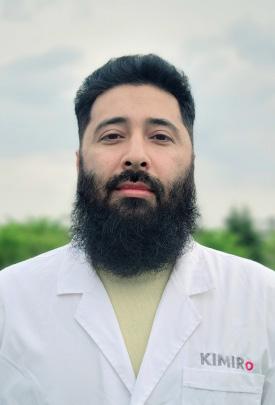
Saqib Sharif is a robotics engineer with a PhD in mechanical engineering, specializing in the design of smart healthcare devices and microrobots. With a strong background in medical technology and innovation, he is passionate about creating solutions that enhance smart healthcare. Dr. Sharif has been living in Gwangju for the past ten years. Currently, he serves as a senior researcher at Shinsung Tech Pvt. Ltd., Gwangju.
Graphic courtesy of Saqib Sharif.
By David Shaffer

Recently, I was reading an article on English language teaching, and an initialism popped up at me that I didn’t immediately recognize: SDGs. Though not specific to the teaching profession, “SDGs” are much talked about in our field. This led me to think that if retrieval of acronyms and initialisms such as SDG are not always immediate for me, with my decades of association with such alphabet soup, the stew just might be overwhelming to the educator new to English teaching. Hence, the birth of this article.
First, however, an explanation of the difference between the terms acronym and initialism may be in order. These are both capital-letter abbreviations, but an acronym, in its strict sense, is a capital-letter abbreviation that is pronounced like a word (e.g., “UNESCO” and “NASA”). On the other hand, each letter of an initialism is pronounced separately (e.g., U-S-A for “USA” and D-M-Z for “DMZ”). So, “SDG” is an initialism (standing for “sustainable development goal) rather than an acronym.
The English language teaching field cherishes its capital-letter jargon as much as any, if not more so than many alphabet-soup lovers. Let’s begin our discussion with the initialism found in the title above. “ELT” stands for “English language teaching,” but contrary to what one may readily assume, it does not refer to all English teaching: It is limited to teaching English to learners whose mother tongue is something other than English. The teaching of English to native English speakers, such as that which my secondary school English teachers labored to teach me, is referred to as “English language arts” or sometimes just “English teaching.”
Not all ELT, however, is the same. The field is often subcategorized into ESL (English as a second language) and EFL (English as a foreign language) – the difference residing in the terms “second language” and “foreign language.” When the language learning context is such that the learner is learning English is an English-speaking
community, they are learning English as a second language. (Here “community” can refer to any societal group from a small village to a large country.) If the language learning context, however, is one where English is not the language of the community in which the learner is living and learning, they are learning English as a foreign language. For example, if a Korean is living and working in western Canada, and learning English there, they are an ESL student. However, for a Korean learning English in Korea – a nonEnglish-speaking community – they are an EFL student. To muddy the waters, I will mention that this dichotomy is not always adhered to. In North America, “ESL” is often used to refer to both ESL and EFL.
“The English language teaching field cherishes its capital-letter jargon.”
And then there is “EAL,” a term that is in use mainly in English-speaking countries. Its emergence most likely arose from the use of “second language” in “ESL,” where it actually refers to any language other than the learner’s first language (i.e., mother tongue). “EAL” removes the ambiguity of the use of “second language” by standing for “English as an additional language.” It is a cover term that includes both ESL and EFL. And then, too, there’s “ESOL” (English for speakers of other languages). ESOL is basically the same as EAL, except that it is most commonly used to refer to adult learners of English who are living, working, and learning English in an English-speaking country. It is most used in the UK, Ireland, and Australia.
“TESOL” stands for “teaching English to speakers of other languages.” It refers to the professional activity of teaching English to non-native English speakers either in English-speaking countries or elsewhere, and it presupposes the requirement of specialized training. “TESOL” is also used to refer
to courses that are available for training in ELT as well as to course certificates in ELT training (e.g., “TESOL course,” “TESOL certificate.” “TESOL” also stands for “teachers of English to speakers of other languages.” It is the name of the largest ELT association in the world – TESOL International Association – based in North America. You will find it in the names of other ELT associations worldwide (e.g., CATESOL – California TESOL; KOTESOL – Korea TESOL; ThaiTESOL –Thailand TESOL). So, “TESOL” is a profession, it is a training course, and it is an association’s name.
Since we have already discussed the differences between ESL, EFL, and EAL, explaining TESL, TEFL, and TEAL becomes simpler. The former three are learning contexts; the latter three focus on teaching English in the corresponding contexts: “TESL” is “teaching English as a second language,” “TEFL” is teaching English as a foreign language,” and “TEAL” is “teaching English as an additional language.” The use of the terms and the scope of their meanings correspond to those of ESL, EFL, and EAL, respectively. Pronunciation of the acronyms “TESOL” and “TESL” may prove confusing for some. “TESOL” is commonly pronounced “tee-sǝl,” as in diesel, while “TESL” is pronounced “teh-sǝl,” as in vessel.
Here we have barely scratched the surface of the store of acronyms and initialisms that permeate the discourse on English language teaching. There is a plethora of capital-letter terms for learners and educators, teaching approaches, and specialized teaching contexts. We will partake of these in another serving of alphabet soup at a later picnic.

The Author
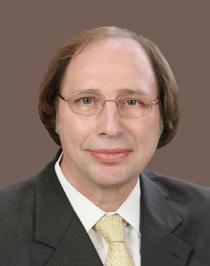
David Shaffer, PhD, has been involved in the field of ELT for decades, teaching EFL students and doing teacher training. He developed and served as director of the TESOL program at Chosun University. Dr. Shaffer’s academic interests include SLA, TBLT, and PBL. He is also a board director for Korea TESOL and AsiaTEFL.
By Anastasiia Prysiazhniuk

Students and volunteers of the KONA Storybook Center.
Icame to Gwangju to study Korean as a GKS-IRTS scholar, but I ended up finding something even more meaningful. Through a friend, I learned about the UNESCO KONA Storybook Center and started volunteering there, helping with English classes. What began as a way to try something new turned into a much deeper experience – one that connected my background in Ukraine with the people I was meeting in Korea.
As a Ukrainian living in Korea, I realized I was in a unique position. I wasn’t just helping teach English – I was also sharing my own culture and building a small bridge between two countries that are located far from each other. Language was a tool for communication, of course, but it was also a way to build understanding. That part mattered to me most.
KONA is a unique place and stories are at the heart of everything they do. We used picture books and short stories in almost every session, whether we were working with kids or adults. At Jungheung Library, as an example, we ran casual reading groups where students would read aloud, act out characters, or just talk about lessons gained from the stories.
At two local schools in Gwangju, we gave short presentations about Ukraine to elementary
students. These were fun and interactive, mixing English learning with cultural exchange. The students were always excited to ask questions and learn about a country they didn’t know much about.
One method that we used a lot was speed reading. Coming from Ukraine, this was familiar to me – speed reading has been part of education back home for years, especially when it comes to learning foreign languages like English. I was surprised and happy to see that the KONA center also uses it as a core part of their teaching approach. It really helps students read with more confidence and understand more in a short amount of time.
While I was helping others improve their English, I was also learning Korean every day – through real conversations, daily practice, and even during translation activities. I often helped with simultaneous translation during presentations, which pushed me to keep learning and improving.
Volunteering gave me the chance to talk about Ukraine, answer questions, and share my perspective. But more than anything, it showed me how powerful traditional stories and shared learning can be. This experience wasn’t just about teaching English. It was about connecting two cultures – those of Ukraine and Korea – through stories, language, and mutual curiosity.


Anastasiia Prysiazhniuk is a GKS-IRTS scholar from Kyiv in Ukraine, a graduate of Kyiv National Linguistics University, and currently based in Gwangju. She is focused mainly on teaching, translation, and cultural exchange, especially sharing the richness of Ukrainian culture through language education and volunteering.
Photograph courtesy of Anastasiia Prysiazhniuk and the UNESCO KONA Storybook Center.
By A. Ayuningsih
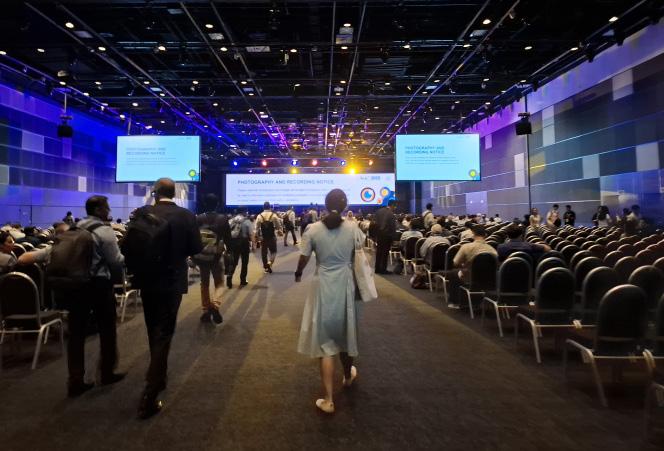
Not long ago, I found myself sitting in a large conference hall in South Korea, surrounded by academic posters and PowerPoint slides packed with technical jargon. It was the kind of event that appeared impressive from the outside: featuring big names, serious panels, and formal attire. But as I listened, I couldn’t help but ask myself: What exactly are we doing here?
I came to Korea as a master’s degree student, with full intention and excitement to learn. I didn’t come just for a degree, I came for something more profound: growth, clarity, meaning. But after months of study and moments like that conference, a quiet question keeps tugging at me: What is this all really for?
That question got louder after I read a statistic that stunned me. According to a Korean newspaper report, 77 percent of young Koreans categorized
as “economically inactive” said they had no plans to find a job. That’s in a country with one of the highest rates of higher education participation in the world. It made me stop. What’s going wrong when a society invests so heavily in education, but its young people still feel stuck or directionless?
“Are we still learning? Or are we just surviving in a system that keeps moving, whether we know where it’s going or not?”
I know that studying to get a job is a shallow reason. We’ve heard that critique before. However, honestly, higher education feels like a performance these days. A series of checkboxes: degrees, certificates, publications. A kind of
illusion of progress – on paper, everything looks impressive. But underneath, many of us feel hollow, even lost. We’re busy, constantly. We are rarely asked to slow down and think deeply. We’re trained to solve complex problems, but not encouraged to ask, “Why are we solving them? Who is this all for?”
“In the end, the goal isn't just to collect degrees. It’s to understand, in some meaningful way, why we showed up to learn in the first place. ”
I’ve asked my fellow grad students, “What are we doing with this research?” or “What comes after your master’s or PhD?” Most pause, give a nervous laugh, and say something like, “Well… I’ll probably do a PhD, then maybe a postdoc, maybe become a professor or go into research.” It’s a script many of us repeat, but fewer of us understand. It’s a loop that feels safe, but also strangely empty.
Don’t get me wrong; higher education can be powerful. Academic titles can represent hard work and deep thinking. Becoming a “doctor” is still a badge of honor in many places. But when all of that becomes more about status, output, and rankings, and less about meaning, growth, or responsibility, something vital gets lost. So, I’ve been wondering, “Are we still learning? Or are we just surviving in a system that keeps moving, whether we know where it’s going or not?”
Some might call this questioning naïve, maybe even privileged. But I think the opposite is true. The fact that so many students are burning out, so many graduates feel disoriented, and so many researchers are disillusioned, that’s not a personal problem. It’s a structural one. Perhaps it’s time we
reconsider not just what we learn, but how and why we know it in the first place.
What would it look like if universities made more room for reflection instead of just assessment? What if classes carved out space for conversations about values, not just content? What if faculty weren’t just seen as experts, but also as mentors who ask tough questions and create space for uncertainty? We don’t need less knowledge; we need more curiosity, humility, and honesty in how we pursue it.
Education shouldn’t just be a race to the next title or publication. It should be a place where we learn to connect knowledge with purpose, to think clearly and feel deeply, to develop skills and integrity. We need to stop assuming that students will magically find meaning along the way. If the university doesn’t help us ask who we are and what we stand for, then what is it doing?
Higher education may not be broken, but it does seem adrift. It keeps pushing ahead, yet the direction feels increasingly uncertain. Perhaps that’s precisely why now, more than ever, we need to pause and ask the kinds of questions that don’t come with neat, immediate answers. Not just “What is your thesis about?” but rather “Who are you becoming through the process of doing it?”
Because in the end, the goal isn’t just to collect degrees. It’s to understand, in some meaningful way, why we showed up to learn in the first place.

The Author

A. Ayuningsih is a graduate student seeking to express the concerns she observes in her surroundings. She hopes that her words may raise awareness and offer a meaningful contribution to the broader community and society in which she lives.
Photograph by A. Ayuningsih.
By Saqib Sharif
This August, Gwangju’s Kim Daejung Convention Center will once again transform into Asia’s premier content and entertainment hub as the 2025 Gwangju ACE Fair (Asia Content and Entertainment Fair) returns from August 28 to 31. Now celebrating two decades of creativity and collaboration, the event marks its 20th anniversary, coinciding perfectly with the city’s Year of Visiting initiative.
ACE Fair Gwangju 2025 will spotlight a sweeping range of industries – from broadcasting and OTT platforms to animation, character licensing, digital content, gaming, metaverse, AR/VR/XR, and edutainment. More than 400 companies from over 30 countries will occupy 503 booths, with around 197 international buyers expected to engage in over 1,400 business matchmaking meetings, building on last year’s booming numbers.
Key organizers and sponsors include the Ministry of Culture, Sports, and Tourism of Korea and Gwangju Metropolitan City, with support from


the Korean Communications Commission, Ministry of Science and ICT, Gwangju Tourism Organization, KOTRA, and others. Official certifications from UFI and the Ministry of Trade, Industry, and Energy cement the event’s global credibility.
A central magnet will be the CDC, where industry titans and thought leaders convene. Last year’s conference addressed AI-driven content and virtual entertainment, with a keynote appearance by Pixar’s Dylan Sisson. In 2025, the CDC returns with fresh insights into generative AI, IP expansion, and the evolving streaming landscape – perfect for content developers and innovators worldwide.
Rather than simply renovating the old attractions, the city has embarked on an ambitious 19-billionwon (approximately US$14.3 million) project that would completely transform the park
into something unprecedented in Korea – a comprehensive art garden that celebrates Asian culture while providing modern recreational facilities for all ages.
More than B2B and B2C exchange, the ACE Fair also offers rich cultural experiences – from metaverse zones and youth content competitions to board games, character parades, job fairs, and educational fringe programs. Visitors can soak in local flair through Gwangju cultural tours, food stalls, and guided excursions designed to showcase the city alongside its creativity.

I fondly recall attending the 2024 ACE Fair with my two young children. Their wide-eyed excitement at strolling through vibrant booths showcasing animated characters and VR experiences was unforgettable. One memory that remains vivid: the Metaverse Experience Zone, where they donned VR headsets and gasped as they “entered” other worlds – hands waving at
virtual creatures, faces alight with amazement. We also joined a character parade, with costumed mascots dancing, and the kids rushed to meet them, cheeks flushed with joy.
We wandered through the animation pavilion, where my daughters got a cherished autograph from a beloved character illustrator. We gathered around a board-game competition that gave us an unexpected family win, high-fiving and celebrating amid cheers. It was more than a business showcase; it was a family exhibition of imagination, technology, and culture.
This year, we’ll return, and I’m particularly excited for them to explore the AI-driven CDC sessions. Maybe this time, they’ll join a youth pitching contest of their own creation!
In sum, the Gwangju ACE Fair 2025 promises a fusion of commercial opportunity and cultural enchantment. Whether you’re a global media executive, an aspiring creator, or a family eager to explore the frontiers of entertainment, this fair is where future-forward content meets heartfelt experiences. See you at the ACE Fair this summer!

Web Sources
• ACE Fair 2025 Official Website (https://www.acefair. or.kr/)
• ContentAsia Feature on ACE Fair 2025 (https://www.contentasia.tv/features/experiencefuture-entertainment-ace fair-2025)

Saqib Sharif is a robotics engineer with a PhD in mechanical engineering, specializing in the design of smart healthcare devices and microrobots. With a strong background in medical technology and innovation, he is passionate about creating solutions that enhance smart healthcare. Dr. Sharif has been living in Gwangju for the past ten years. Currently, he serves as a senior researcher at Shinsung Tech Pvt. Ltd., Gwangju.
Reviewed by Michael Attard
Light in August
By William Faulkner
Vintage International, 1990 (Original 1932)
ISBN-10: 0-679-73226-8
William Faulkner, the author of Light in August, was born in Mississippi in 1897. This fictional story takes place in the 1930’s. Historically, it was a time of Prohibition (of alcohol) and Jim Crow laws, that is, statutes that legalized racial segregation.
The first character to be introduced is Lena, a young white woman who is pregnant with the child of a man named Lucas Burch, who has run off to escape any responsibility. But Lena is not upset, as she believes what the man has told her about sending for her when he had things all set up in another place. Six months later, Lena is a little tired of waiting, and she sets off to find him. The reader is induced to believe that the story is about Lena, but that is only minimally true. However, through her callow manner, she plays a key role in exemplifying one of the book’s themes: the human capacity for resilience.
Lena meets Byron Bunch, a main protagonist, at the sawmill where she is correct in believing that her beau Lucas had worked. Byron is a Godfearing man and not someone that most pay much attention to. Through his character, the author expresses views on human nature and a fascination of human spirit, especially with regards to man’s capacity for good and evil. Of the two, we see much more of the latter.
The author delves into the exploration of the human psyche within the realm of the South’s constant obsession with race and blood. An
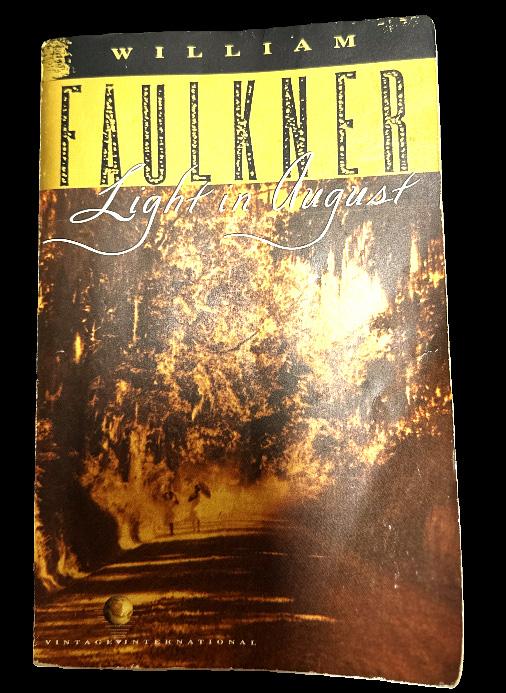
Cover of Michael’s copy of Light in August. (Michael Attard)
obsession made incarnate in the character with the name “Christmas.” The reader is introduced to Christmas as a man in his thirties, working at the above-mentioned sawmill. But the author takes us back to his abandonment at birth and then brings us forward through years of mistreated upbringing. The greatest factor, ostensibly dooming Christmas, is his being oneeighth Negro. And yet, it is Christmas, who can easily pass as white, who tells people about his mixed blood. His entire existential essence is tied up in blood and race. The fact that Christmas burdens himself with his very being and that the whites are compelled to want to kill him is at the crux of the book.
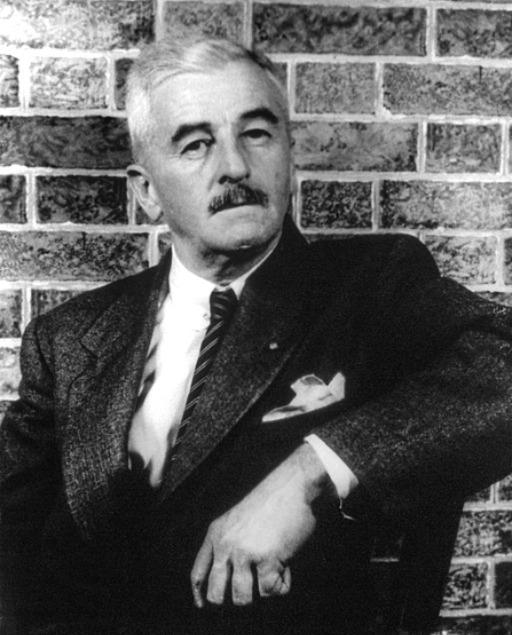
Christmas is on the run after a white woman, Joanna Burden, his sometimes lover, and upon whose property he lived, is found murdered. Christmas’ hostility toward Joanna and women in general is clear evidence of misogyny. Christmas seems to resent and becomes indignant at the mere idea that a woman would care about him in any way. Not being able to sleep one night, he says, “It’s because she started praying over me.”
Misogyny is evidenced elsewhere. A defrocked minister and friend of Byron knows that Byron has fallen in love with Lena. He admonishes his friend, “But what woman, good or bad, has ever suffered from any brute as men have suffered from good women?”
I was bothered by this, and curious of the author’s personal views. According to some scholars, Faulkner was a feminist as evidenced by his nontypical representations of women. But it is racism that lies at the core of the story. And in speaking of it, the language used is often offensive. And why wouldn’t it be? Racism is offensive. So, while ultimately Faulkner is attempting to inspire our better nature, he feels obliged to correctly record history.
Christmas is the central character in the story, and he is a complicated figure. He is protagonist and antagonist simultaneously. But superseding all that he is and he isn’t, he is a tragic figure. And truly tragic in that he never understands himself: “…he believed with calm paradox that he was the volitionless servant….”
The book is a masterful read. Every page is brighter than life through the author’s keenest sense of perception. With respect to a minor character, he says, “Her voice is not tentative so much as rusty.” In another scene, the character is captured wholly and succinctly: “…with something in his glance coldly and violently fanatical and a little crazed, precluding questioning.”
At the same time, the book is often not that easy to read. There occasionally seems to be a disconnect between what is happening and what is being said, as what appears to be being said is sometimes merely being thought. Faulkner has been credited for his pioneering use of stream of consciousness.
The tragic story ends, somewhat as it began. Lena is on the road, traveling nowhere in particular. This time though, she is with her baby and Byron. She is content, even happy. She found and quickly lost her beau, the father of her child, but her resilience and perseverance have only strengthened her spirit.
William Faulkner never graduated from university, yet he won the Nobel Prize for Literature in 1949.


The Author

Michael Attard is a Canadian citizen but has lived in Gwangju for over twenty years. He has taught English as a second language in academies and within the public school system. He is officially retired and spends time reading, writing, hiking, and spending time with friends.
By Dhivyaa S. P.
At the start of 2025, I made a simple bingo board – half goal-setting, half playful hope. In one of the squares, I wrote: “Attend at least one concert.” That was it. Just one. Life, as it often does, decided to rewrite that wish in bold. As of now, I’ve stood amidst glowing light sticks, cheering crowds, and surreal stages not once, but three times.
First Beat: “Hope on the Stage” Feb 28, 2025 | KSPO Dome Seoul Day 1
That day began with chaos. My mind was cluttered with deadlines and research paper submissions. The idea of attending my first K-pop concert felt more like checking a box than a dream come true. Still, I made my way to KSPO Dome, arriving around 3:30 p.m. – solo, slightly disoriented, and half-hungry.
Most cafes and restaurants were already full, and the crowd overwhelmed me. So, I settled for a familiar CU gimbap and wandered into a nearby park – quiet, shaded, and strangely comforting. That brief solitude became my pre-concert ritual. By 5:20 p.m., I’d passed through the gates using the face pass system I’d registered earlier. No ID checks. Just a seamless scan and step into the concert world.
Inside, the energy was electric. Fans exchanged photocards, candies, and handmade cheering cards like old friends. Beside me were two girls – one from Busan, the other from Japan – both attending their first concert too.
Then came J-Hope of BTS.
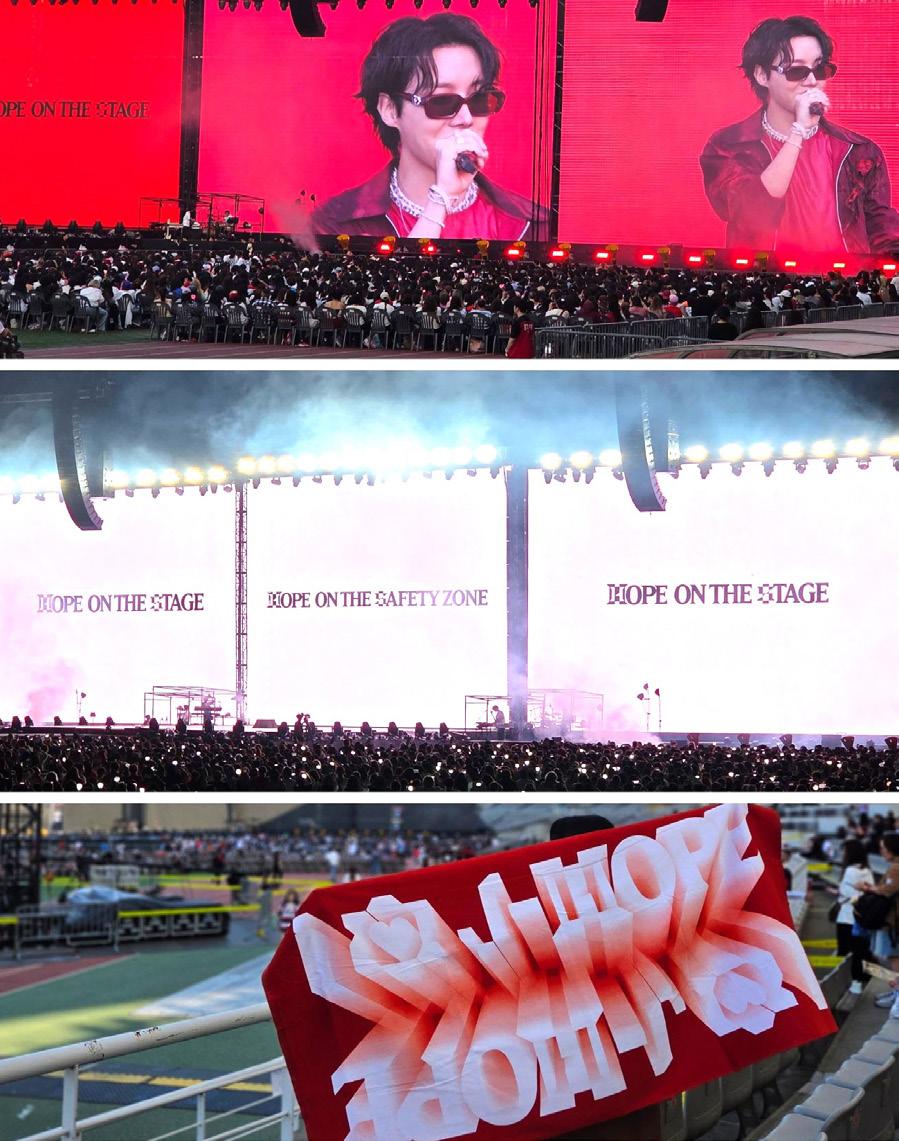
His presence? More than Magnetic. His performance? He set the place on fire. Arson. His stage? Pandora’s Box, unleashed. His energy? Straight out of Hope World.
And though he didn’t sing my favorite track that night, I left with a strange emotion. What some call “post-concert depression.”
Second Stage: “Hope on the Stage – FINAL” Jun 15, 2025 | Goyang Stadium Day 2
The stadium was massive. Open sky, wider crowds, and a new seatmate: a Japanese
grandmother. We may have been decades apart, but we both swayed, smiled, and melted into the music like teenagers.
Though I couldn’t see J-Hope up close this time, the view of the fireworks was worth every seat trade-off. And just when I thought I’d missed my chance again, he sang “Safety Zone” – my favorite – as his tour closing song.
I wanted to cry. But the heat that day was brutal. I was so dehydrated, even my emotions felt dry. The walk to the subway post-show was an endless, packed crawl. I remember whispering to my friend, “They really need a better crowd dispersion plan.”
Jun 28, 2025 | Goyang Auxiliary Stadium Day 1
By the time Seokjin’s solo concert rolled around, I had grown into the rhythm of K-pop concert days – timing meals, picking outfits, even learning when to arrive to avoid crowds. This was a day trip from Gwangju.
The open venue welcomed us with humidity, bugs, and excitement. Yet what made this concert special wasn’t just the music. It was the games, the humor, and the way Jin interacted with fans like an older brother teasing his siblings. I laughed more than I expected. It felt light and spontaneous.
All my tickets were booked through the Korean Interpark (now NOL) system. The first time was chaotic – fan club pre-sale failed because the CAPTCHA wouldn’t load. I stared at the screen for 20 minutes before realizing it wasn’t going to work. But somehow, the next day during general sales, I got a ticket. A miracle, considering every section I clicked turned gray instantly. For the other two concerts, I learned my lesson: click quickly to clear the CAPTCHA, and get in during fan reservations.
If you’re planning your first concert in Korea, here are few things to keep in mind:
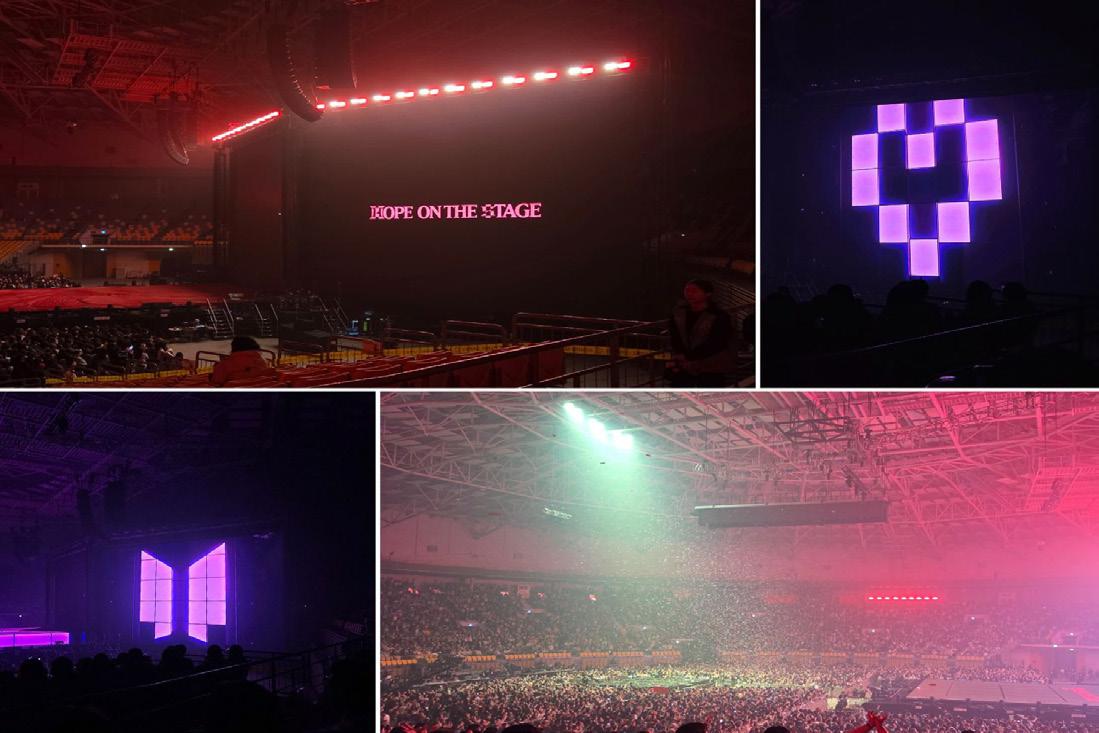
• Be early. Nearby cafes and restaurants fill up fast. You might have to stand for hours otherwise.
• Eat beforehand. Carry snacks, candies, and juice to keep your energy gently fueled through the day.
• Use Face Pass. Register in advance for quicker entry.
• Shop smart. Tour merch can be bought via the Weverse App when you’re within about 2.5 km of the venue, but it sells out quickly.
• Carry an extra bag. Fans will hand out freebies like photocards, stickers, and even fan-made goods.
• Expect chaos after the show, especially near the subways and bus stops. Patience is your best companion.
What began as a simple bingo goal turned into something unforgettable. Dear future me, never stop showing up for the things that make your heart race. Next spring, I’m looking forward to the full-group reunion tour. Until then, I’ll hold on to these memories, while humming “Safety Zone.”

The Author Dhivyaa S. P. believes that every action, no matter how small, contributes to the bigger picture of change. #bekind #beyourself
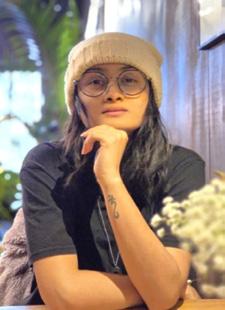
By Zhang Jiuzhou (Julius)
Once languishing at the bottom of the standings early in the season, the Kia Tigers have climbed their way back into the playoff picture, overcoming a spate of injuries to key players. Now on the verge of rejoining the league’s top tier, their resurgence has become one of the most compelling narratives of the season.
Star infielder Kim Do-yeong, sidelined for much of the first half, is reportedly progressing well in his recovery. “Kim showed signs of improvement in his checkup,” said a club official, “but we are targeting a mid-August return to ensure he recovers fully.”
In the meantime, veteran players like Choi Hyoung-woo, Patrick Wisdom, Park Chan-ho, Kim Tae-gun, and Choi Won-jun have helped stabilize the lineup. Additionally, standouts from the Kia Tigers 2nd Team – Kia’s Futures League affiliate – have stepped up to fill the void. With reinforcements due to return soon, Kia is widely tipped to mount a serious title challenge in the second half of the season.
Much of their recent success stems from a revitalized pitching staff. After posting a team ERA of 4.47 in May (7th in the league), the Tigers improved significantly in June, lowering their ERA to 3.47 – good for second-best in the KBO. Foreign aces James Naile (2.68 ERA) and Adam Oller (3.03 ERA) have anchored the rotation,
while Jeon Sang-hyeon, Sung Yeong-tak, Jung Hai-young, and Cho Sang-woo have bolstered the bullpen.
Oller, in particular, has been a workhorse, racking up 12 quality starts and consistently eating innings. Jeon Sang-hyeon, meanwhile, notched his 100th career hold after returning from a serious shoulder injury. Kia also appears to have found a long-term ace in rookie righthander Kim Do-hyun, who boasts a 3.18 ERA in the first half – ranking fifth among domestic pitchers and 13th overall. With Naile, Oller, Yang Hyeon-jong, and now Kim, the rotation is nearly complete. If fellow starter Yun Young-cheol can maintain consistency, Kia’s title aspirations will only grow stronger.
Even so, expectations for the “Hampyeong Tigers” contingent – nickname for the standouts from the 2nd team – may need to be tempered. Their outstanding performance in the first half is unlikely to be sustainable indefinitely, making it crucial for regular starters to pick up the slack going forward.
The Korea Football Association (KFA) has received backing from FIFA in its ruling that Gwangju FC players should be deemed eligible despite administrative oversights that led to the club’s registration ban. FIFA stated that it
would “respect KFA’s judgment regarding player eligibility in domestic competitions,” essentially averting a crisis that could have led to multiple match forfeits.
The original controversy stemmed from Gwangju FC’s failure to pay a $3,000 solidarity contribution linked to the signing of Jasir Asani. Due to a clerical mishap involving an employee on parental leave, the payment went unprocessed and the club remained unaware of the subsequent FIFA sanction.
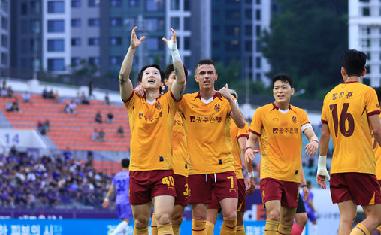
Despite this reprieve, the club continues to face severe financial challenges. Although Gwangju receives municipal funding comparable to that of other clubs, its payroll expenses have ballooned to 9.6 billion won – more than even the corporatebacked Pohang Steelers. Player salaries jumped 62.4 percent year-on-year after Gwangju’s thirdplace finish in the 2023 season and qualification for the 2024–25 AFC Champions League Elite.
This rapid rise in expenses has not been matched by revenue. With average home attendance at just 4,215 – second-lowest in K League 1 – Gwangju has struggled to generate commercial income.
To offset a 4.1-billion-won deficit, the club had been preparing to sell its most valuable asset: Jasir Asani. However, following a 1–0 Korea Cup quarterfinal win over Ulsan HD on July 2, head coach Lee Jung-hyo dramatically reversed course.
“We can’t sign new players, and we can’t let anyone go. We need to keep what we have,” Lee said. Gwangju is now one win away from reaching
the Korea Cup final, their first shot at silverware since winning K League 2 in 2022.
Asani remained noncommittal: “I’m grateful for the coach’s support, but no one knows what the future holds. For now, I’m just focused on helping the team.”
The AI Peppers women’s volleyball team has entered a period of major transition as it prepares for the 2025–26 season. After a dismal showing at the Korean Industrial Volleyball Federation and Futures League Championship –winning just one out of four matches – the team has begun reshaping its roster.
The club announced via social media that it had parted ways with Chae Seon-ah, who joined in 2023 on a three-year, 300-million-won contract. Despite appearing in 29 matches during the 2023–24 season, she did not play at all in 2024–25. “She left for personal reasons,” the team stated. The AI Peppers also released two recent draftees: libero Oh Sun-yae and outside hitter Ryu Hye-seon, neither of whom made a first-team appearance.
In a more emotional departure, the team terminated the contract of 194-cm middle blocker Yeum Orkhon. The Mongolian player, who had struggled with injuries and undergone surgery, has returned home. “We’ve told her she’s welcome back anytime. We wish her a full recovery,” the club said.
These moves signal a rebuild for the AI Peppers, but also raise questions about the team’s readiness to compete in the upcoming season.

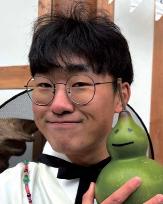
Zhang Jiuzhou (Julius) is from Harbin, China. He began writing in 2022 and has contributed to the Chinese media in Gwangju. He concurrently serves at a sports data company. He is pursuing a master’s degree in media and communications and is responsible for the Chinese Students Association at Chonnam National University.
By Zhang Jiuzhou (Julius)
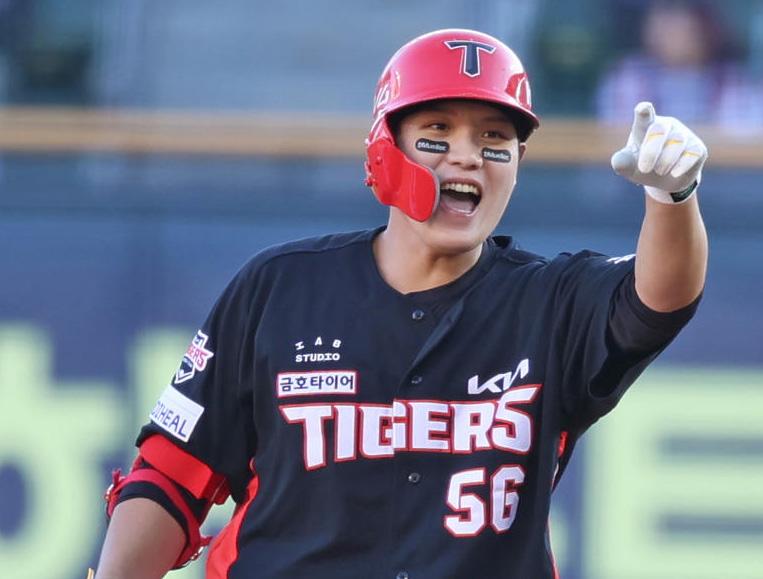
The queen, rook, and knight are all forcibly knocked off the board, yet the side still finds a way to win – that’s the story of the Kia Tigers. They’ve clawed their way up the standings and are now threatening the league’s top teams.
At the start of the 2025 KBO season, few would have predicted the Kia Tigers – once hailed as
a title favorite – would find themselves clawing their way up from the bottom of the standings. Beset by a brutal string of injuries to key players, including Kwak Do-gyu, Na Sung-bum, Kim Doyeong, Hwang Dong-ha, and Kim Seon-bin, Kia stumbled early, dropping to last place in midApril. By the end of May, they were languishing with a .481 winning percentage, and many doubted they could recover.
But in June, something unexpected happened: A group of unheralded players from Kia’s Futures League affiliate in Hampyeong – dubbed the “Hampyeong Tigers” – rose to the occasion and reignited the team’s playoff hopes. Backed by standout performances from names once unfamiliar to fans, Kia roared to a league-best .682 winning percentage in June and began climbing the table, even threatening the top-tier teams.
Outfielders Oh Seon-woo and Kim Ho-ryeong, alongside hitters like Ko Jong-wook and Kim Seok-hwan, and pitchers Lee Ho-min and rookie reliever Sung Yeong-tak, have defied expectations. For a team once considered out of contention, this resurgence has been nothing short of miraculous.
The Korean proverb “If you have no teeth, live with your gums” captures the Tigers’ fighting spirit – what some are now calling “gum baseball.” Deprived of their star players, the Tigers have built a winning campaign through passion, resilience, and unity. Young players used to just sit on the bench, hoping for one or two at-bats. Now, they play with the mindset of starters – and they’re seizing the opportunity.
One of the most remarkable comebacks is that of veteran Ko Jong-wook. Once a .300 career hitter with Nexen and SK, Ko saw his role diminish significantly in recent seasons. “I didn’t even play in spring training,” he admitted. “I thought it might be my last shot, so I prepared like it was the end.” His return has been a revelation, and fans have embraced him once more as a spark plug in the lineup.
June also saw center fielder Kim Ho-ryeong named the club’s Player of the Month by Kysco. In 22 games, he batted .271 with 19 hits, 11 RBIs, and 9 runs scored. Known for his elite defense since being drafted in the 10th round in 2015, Kim has long been praised for his glove work but struggled with consistency at the plate. That
seems to be changing – on July 5, he launched the first multi-home run game of his 11-year career, including a grand slam.
Rookie right-hander Sung Yeong-tak, the club’s 10th-round pick (96th overall) in the 2024 draft, was selected as June MVP by Kia’s designated medical sponsor. In 13 relief appearances that month, he pitched 15.1 innings with a stellar 1.17 ERA and 9 strikeouts. He also set a club record for the longest scoreless streak by a debut pitcher, going 17.1 consecutive innings without allowing a run – third-longest in KBO history.
Manager Lee Bum-ho credits the team’s culture for the turnaround: “I try not to interfere too much. I let the players come together and take ownership.” He added, “When they decide for themselves what they want to do and prepare for the game accordingly, that’s when we see the best results.”
With their stars gradually returning from injury, Kia is poised for a full-scale assault on the championship race in the second half of the season. From a team once written off to a club on the rise, the Hampyeong Avengers-fueled Tigers have emerged as one of the most compelling stories of the 2025 KBO campaign.

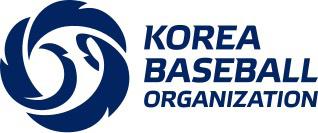

Author Zhang Jiuzhou (Julius) is from Harbin, China. He began writing in 2022 and has contributed to the Chinese media in Gwangju. He concurrently serves at a sports data company. He is pursuing a master’s degree in media and communications and is responsible for the Chinese Students Association at Chonnam National University.
OPERA
2025 Moonlight Alliance Opera Exchange: Andrea

Dates: August 29 & 30 (Fri. & Sat.)
Times: Friday at 7:30 p.m., Saturday at 3:00 p.m.
Duration: Approximately 150 minutes (including intermission)
Venue: Grand Theater, Gwangju Culture and Arts Center
Ticket Prices: V Class: 120,000 won; R Class: 80,000; S Class: 50,000; A Class: 30,000; B Class: 20,000
Admission: Ages 7 and up
Reservations: Gwangju Culture and Arts Center website (1588-7890), TicketLink
Inquiries: 062-412-2502
Gwangju Children’s Choir: Liberation 80th Anniversary Concert

Date: August 14 (Thur.)
Time: 7:30 p.m.
Duration: 85 minutes
Venue: Grand Theater, Gwangju Culture and Arts Center
Ticket Price: 10,000 won
Admission: Ages 4 and up
Reservations: Gwangju Culture and Arts Center website (1588-7890), TicketLink
Inquiries: 062-613-8246
ACC Brunch Concert: August –Maria Kim with Strings

Date: August 20 (Wed.)
Time: 11:00 a.m. –12:20 p.m.
Venue: ACC, Theater 2
Ticket Prices: R Class: 30,000 won; S Class: 20,000
Admission: Ages 7 and up
Reservations: ACC
Foundation website / Onsite box office / Call center
Inquiries: 1899-5566
Gwangju Philharmonic Orchestra Otium Concert III: “Flute
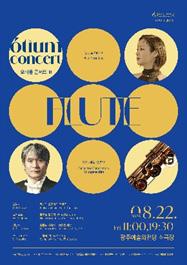
Date: August 22 (Fri.)
Time: 7:30 p.m.
Duration: Approximately 70 minutes
Venue: Small Theater, Gwangju Culture and Arts Center
Ticket Prices: S Class: 20,000 won; A Class: 10,000
Admission: Elementary school students and older
Reservations: Gwangju Culture and Arts Center website (1588-7890), TicketLink Inquiries: 062-613-8241
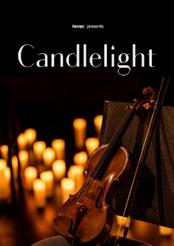
Date: August 24 (Sun.)
Time: 4:00 & 7:30 p.m.
Duration: 65 minutes
Venue: Theater 2, Gwangju Culture and Arts Center
Ticket Prices: Section A: 55,000 won; Section B: 44,000; Section C: 33,500
Admission: Ages 10 and up
Reservations: Available on the Fever website
Inquiries: Fever Customer Center
Summer Movie Concert: Ghibli, Disney, Pixar, DreamWorks & Japanese Animation
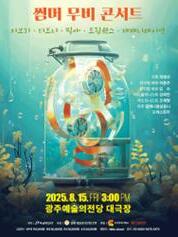
Date: August 15 (Fri.)
Duration: 120 minutes (15-minute intermission)
Venue: Grand Theater, Gwangju Culture and Arts Center
Ticket Prices: VIP: 110,000 won; R Class: 90,000; S Class: 60,000; A Class: 40,000
Admission: Suitable for ages 5 and up
Reservations: NOL Interpark tickets
Inquiries: 1544-1555
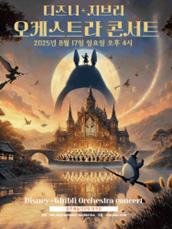
Date: August 17 (Sun.)
Time: 4:00 p.m.
Duration: 120 minutes (15-minute intermission)
Venue: Grand Theater, Gwangju Culture and Arts Center
Ticket Prices: VIP: 100,000 won; R Class: 80,000; S Class: 60,000; A Class: 40,000
Admission: No admission for children under 7
Reservations: NOL Interpark tickets (1544-1555)
Inquiries: 010-9184-7496
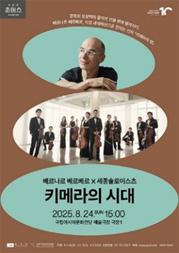
Date: August 24 (Sun.)
Time: 3:00 p.m.
Running Time: 90 minutes (15-minute intermission)
Venue: Theater 1, ACC Theater
Ticket Prices: R Class: 90,000 won; S Class: 70,000; A Class: 50,000
Admission: Ages 7 and older
Reservations: ACC Foundation website, Onsite box office, Call center Inquiries: 1899-5566
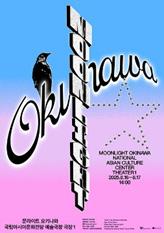
Date: August 16 & 17 (Sat. & Sun.)
Time: 2:00 p.m.
Venue: Theater 2, National Asian Culture Complex Arts Theater
Reservations: Detailed information and ticket sales yet to be announced.


Ticket Price: Free
Dates: July 10 (Thu.) –December 28 (Sun.), 2025
Hours: Tuesday to Sunday: 10:00 a.m. – 6:00 p.m.; Wednesdays & Saturdays: 10:00 a.m. – 8:00 p.m.
(Closed Mondays)
Venue: Complex Exhibition Halls 3 & 4, ACC Creation
Admission: All ages admitted
Reservations: Free viewing Inquiries: 1899-5566
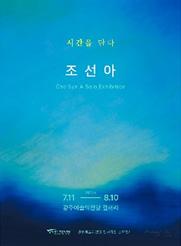
Ticket Price: Free
Dates: July 11 (Fri.) –August 10 (Sun.)
Time: 10:30 a.m. – 7:30 p.m. on performance days; 10:00 a.m. – 6:00 p.m. on non-performance days
Duration: 30 minutes
Venue: Gwangju Culture and Arts Center Gallery
Admission: All ages admitted Inquiries: 062-613-8357
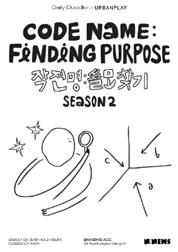
Dates: July 5 (Sat.) –August 31 (Sun.)
Hours: Tuesday to Sunday: 10:00 a.m. – 6:00 p.m.; Wednesdays & Saturdays: 10:00 a.m. – 8:00 p.m.
(Closed on designated holidays)
Venue: N:News ACC (Next to Exit 6 staircase)
Ticket Price: 7,500 won (Free admission for children under 36 months)
Admission: All ages admitted
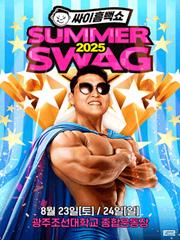
Dates: August 23 & 24 (Sat. & Sun.)
Time: 6:00 p.m.
Venue: Main Stadium, Chosun University
Ticket Prices: Standing SR: 185,000 won; Standing R: 175,000; Reserved Seat: 185,000
Admission: All ages admitted
Reservations: NOL Interpark ticket Inquiries: 1544-1555
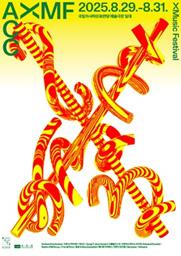
Dates: August 29–31 (Fri.–Sun.)
Venues: ACC Theater 1 (Big Door), Theater 2, Open Plaza, and more
Ticket Prices: 1-Day Pass: 40,000 won; 3-Day Pass: 100,000 (Free admission for children under 7)
Admission: All ages admitted
Reservations: ACC Foundation website / Box office / Call center / TicketLink / Interpark Inquiries: 1899-5566
Compiled by Jung Yeonseo
